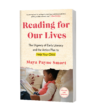Fact: fiction is good for you. So, while it may be tempting to see nonfiction as a somehow more “useful” reading choice, if your child makes a beeline for tales, fables, and all things kid lit (as my four-year-old has done from the get-go), rest easy. Put any worries over fiction vs nonfiction to one side, and instead look for a mix of books that interest your child. One of the best things a parent can do to motivate their child’s learning and development is to follow their reading interests, no matter the format.
What’s more, there are some great reasons why kids should read fiction. Science is now backing up what story lovers have long held true—that fiction brings a host of benefits to readers. Not only does it appear to spark joy, help with relaxation, broaden horizons, and deepen focus, but researchers are discovering that it has an important role to play in other areas too.
Fiction nurtures emotional intelligence, open-mindedness, and altruism
Can reading literature really foster empathy and open minds? Yes, according to a wealth of research over the last two decades. A high “EQ,” or emotional intelligence, is a crucial element of general intelligence, and a key predictor for thriving in life—as highlighted by psychologists John Mayer, Peter Salovey, and Daniel Goleman. It’s as important as IQ, if not more so. And one of the benefits of reading fiction is its positive effect on personal growth and EQ. Studies have shown it fosters:
- Theory of mind—the ability to think about the mental states of others, as well as our own
- Empathy—the capacity to understand and share another’s feelings
- Social cognition—the ability to interpret social information and use it to guide behavior
- Open-mindedness—an attitude necessary for both reasoning and creativity, and a characteristic of high EQ
- Altruism—for example, fiction readers are nearly three times more likely to volunteer than non-readers, independent of education level, age, gender, or ethnicity
Stories are training for real life
Keith Oatley, professor emeritus of cognitive psychology at the University of Toronto, has dug deep into how reading fiction—and the exercise in relating to the perspectives of characters it encourages—can act as a kind of training for real life, specifically our social world.
In his words, fiction is a “particularly useful simulation because negotiating the social world effectively is extremely tricky, requiring us to weigh up myriad interacting instances of cause and effect. Just as computer simulations can help us get to grips with complex problems such as flying … so novels, stories, and dramas can help us understand the complexities of social life.”
Give children access to fiction books, and you can help them learn nuanced lessons about how our societies and communities work.
Literature stimulates language learning
Curious to know what’s going on in your (or your child’s) brain when you read fictional stories?
Researchers in one study took functional MRI scans of several fiction readers’ brains. One finding was that even on the mornings after reading, brain activity was heightened in the left temporal cortex, an area associated with receptivity for language. According to neuroscientist Gregory Berns, such heightened brain connectivity is what experts call “‘shadow activity,’ almost like a muscle memory.”
A 2021 study on reading for pleasure also found that people who read fiction, regardless of its perceived “quality,” have better verbal abilities than those who don’t. If one of the possible benefits of reading fiction—any kind of fiction—is that it flexes the language “muscle,” let’s follow our kids’ interests and give them plenty of room to flex!
Narratives boost comprehension and problem-solving
A skill called “sequencing” is another great argument in favor of why kids should read fiction. Sequencing is being able to identify, organize, and re-tell the order in which events happen, e.g. the beginning, middle, and end of a narrative—and having a good handle on it is a key reading comprehension skill.
Beyond reading, it also plays a huge part in the “step-by-step” of our daily activities, from morning routines to following recipes. Being able to understand and organize information logically through sequencing aids problem-solving across subjects, from math to history, too. So it stands to reason that reading, listening to, and talking about stories (as well as narrative nonfiction) are brilliant ways to strengthen this vital skill.
Tales supercharge reading skills
According to some literacy research, the mix of what a person reads can make a difference to their skills. A study of over 250,000 teenagers’ reading habits across 35 countries found that those who read fiction several times a week had reading scores almost six months ahead of those who rarely or never read fiction.
And this “fiction effect” on reading proficiency held true even when other factors had been taken into account, such as the fact that fiction readers tend to spend more time reading than nonfiction readers. While reading nonfiction also has demonstrable benefits, it’s great to know that stories can be so powerful for developing excellent literacy.
The bottom line: Don’t frame your family reading choices as “fiction vs nonfiction,” but rather as “fiction and nonfiction.” All informed by your child’s personal interests and inclinations.
Are your kids fiction fans? What kinds of stories do they pick out? And what benefits of reading fiction have you noticed?
The winter holidays are often marked by delicious treats and cooking traditions passed down from generation to generation. By sparkly decorations hanging from trees, windows, and fireplaces. And, all too often, by frantic holiday shopping for relatives, teachers, and neighbors.
This holiday season, combine time together in the kitchen with a little light reading practice with your kiddo … all while creating some adorable decorations that also happen to make sweet gifts.
These simple, DIY Christmas ornaments require only two ingredients (applesauce and cinnamon) and very little prep work. They do take a while to cook, so a little patience will come in handy.
In the end, you’ll have festive homemade decorations or gifts that your child made from start to finish. Plus, they smell wonderful! This recipe makes about 15 ornaments, depending on the size of cookie cutters you use.
You can also use this recipe to show your child the different sounds the letter C can make. Print the recipe and ask your child to circle every word they can find with a C in it. Then help them read the words. Point out that the letter most often makes the hard C sound, as in cut, but that it can also make a soft /s/ sound, as in cinnamon or applesauce.
Note that the hard C sound at the beginning of Christmas is an exception from the usual CH sound. You can just help your child read the word without getting into the CH pattern and exception. (If they’re curious and ask about it, explain that some words are pronounced differently than they look, often because of the way spelling and accents evolved over time.)
Then let your child take the lead on reading the instructions, to the best of their ability. If they struggle to read some of the longer words, cover part of the word and see if they can figure it out in segments, like “apple” and “sauce,” and then put them together. Most of all, keep it fun!
This Christmas ornament recipe is part of our Read with Me Recipe series of printable recipes that are super easy to make—and, crucially, read—with children. They feature simple words and short sentences typed in an easy font that will set your little one up for reading success.
Just print out the recipe and then read it with your child as you cook together. (Scroll down for tips on using it to help teach reading.) The idea is to make it easy for you to mix reading and writing into everyday life with your kids. This kind of “everyday literacy” is key to raising thriving readers.
Tips for teaching kids to read with this recipe:
- Introduce your child to how recipes work. If you’re not sure they know them already, be sure to explain vocabulary like “ingredients” and other cooking terms. (Even though we won’t be reading such complicated words in this recipe, they’re important words to learn.) One of the biggest challenges for beginning readers—and most important oral language underpinnings of literacy—is just knowing and understanding all the words they’ll encounter in print.
- Watch out for specific words in the recipe they may not be familiar with (possibly “cinnamon” in this recipe), and give a simple definition.
- Keep an eye out for tricky-to-read words, such as “hours.”
- For little ones who aren’t reading much yet, just pointing out what you’re reading and emphasizing a few key words or letters is enough. If you make the recipe again, you can help them find the words you pointed out before.
- Use this as an opportunity to show them punctuation, as well as words and letters. Point to the commas, periods, or other punctuation marks, and explain what they mean.
- If they can’t read the recipe on their own, give them chances for success by asking them about what they do know, gently underscoring key knowledge. E.g., ask, Can you find a letter T? or What letter does this word start with?
- For kids who are reading already, encourage them to read the recipe themselves. If they have trouble, just calmly help them with any words they can’t quite get. E.g., if they have trouble with the word “applesauce,” try covering “sauce” and helping them read just the first part of the word before you uncover the rest.
- Bring your patience. Give your child space to read a word (or identify a letter) before you jump in, but be prepared to help if they’re showing signs of frustration.
Related: View and print our other Read with Me Recipes.
Applesauce Cinnamon DIY Christmas Ornaments
Notes: These ornaments are not edible, so avoid letting children eat the dough.
Also, the recipe involves using a hot oven and isn’t appropriate for young children to complete alone. Adults should help with baking the ornaments.
- 2 cups applesauce
- 2 cups cinnamon
- Straw
- String
- Cookie cutters
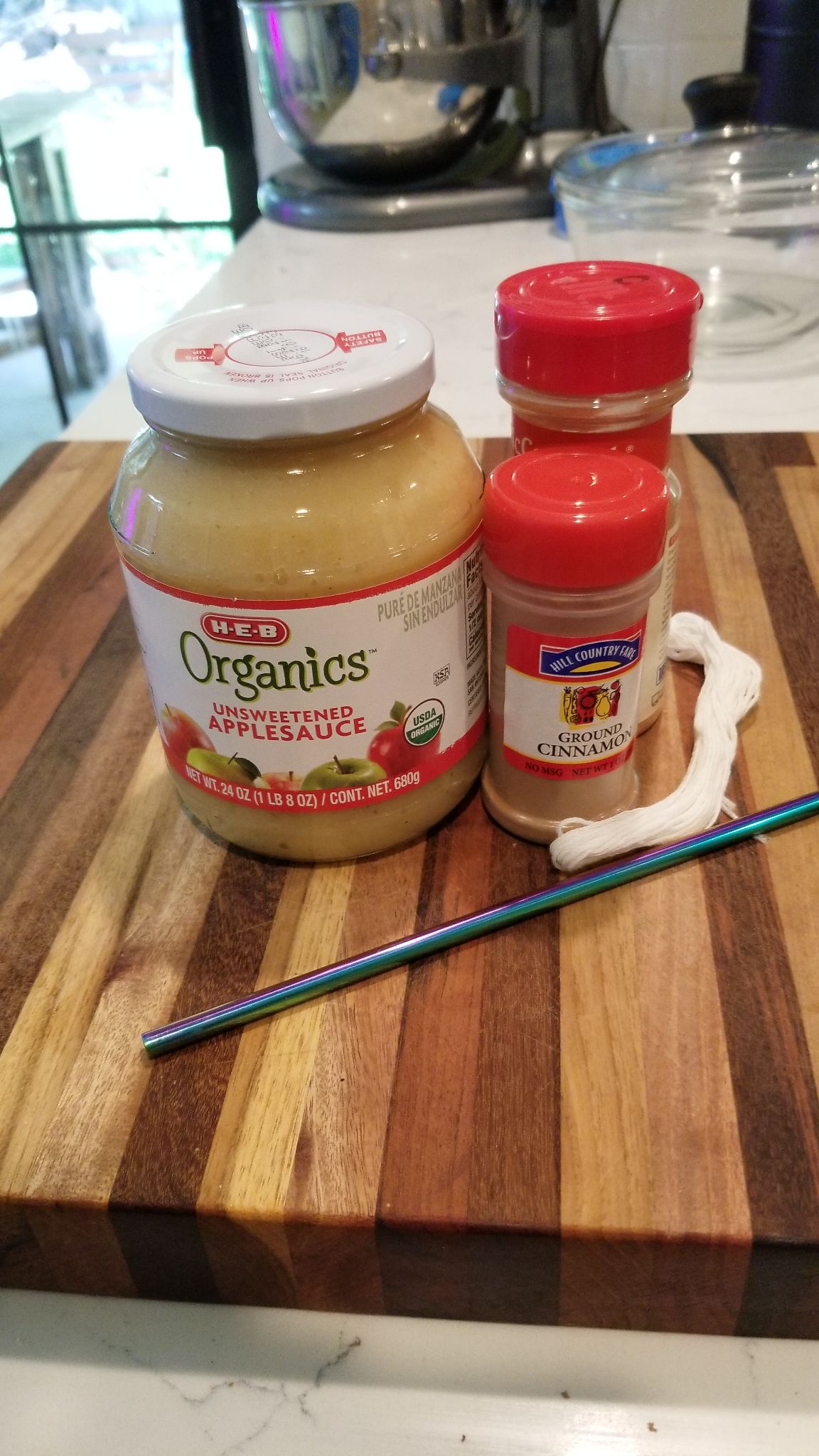
Step 1: Heat the oven to 200 F.
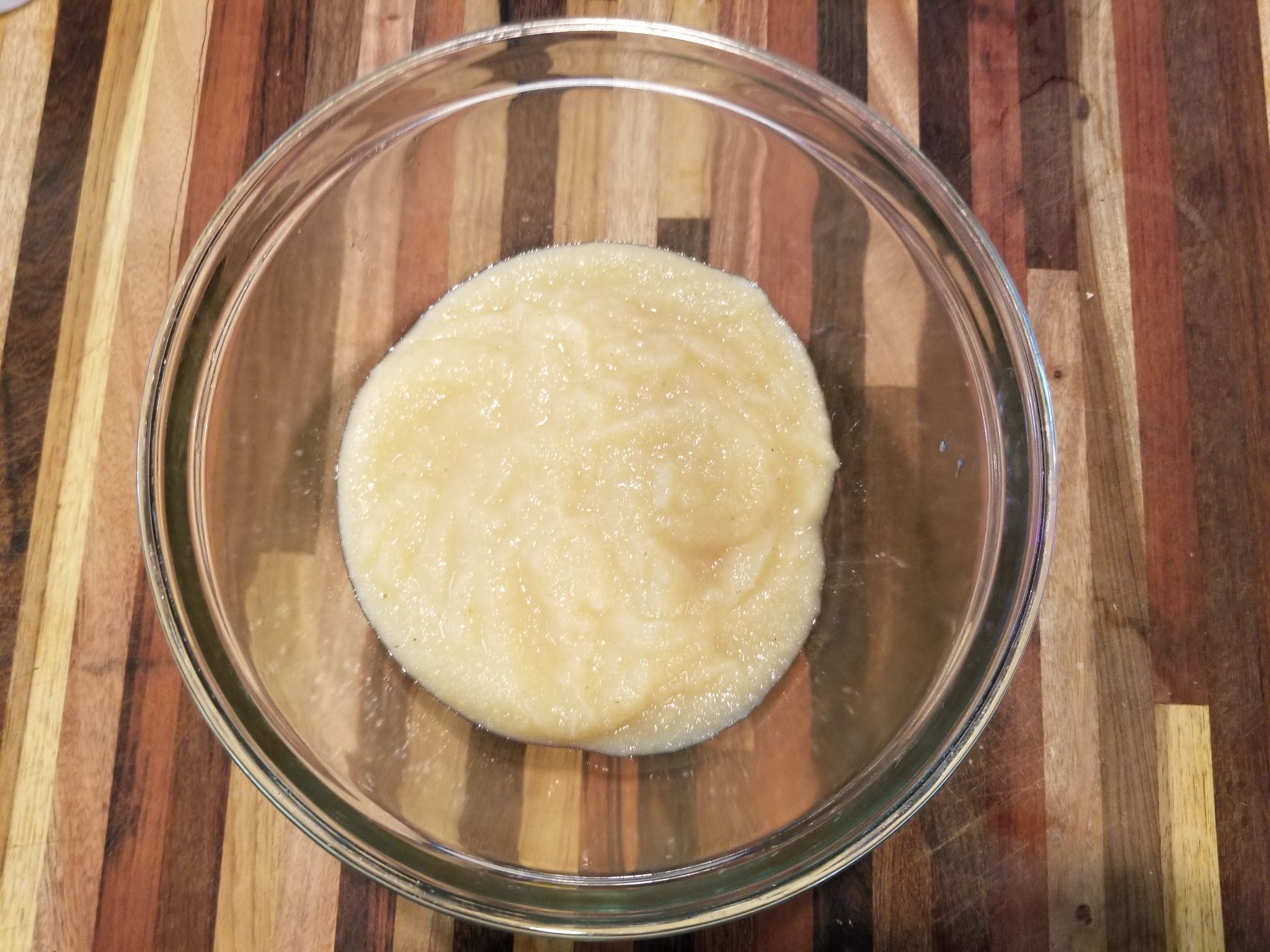
Step 2: Put 2 cups of applesauce in a bowl.
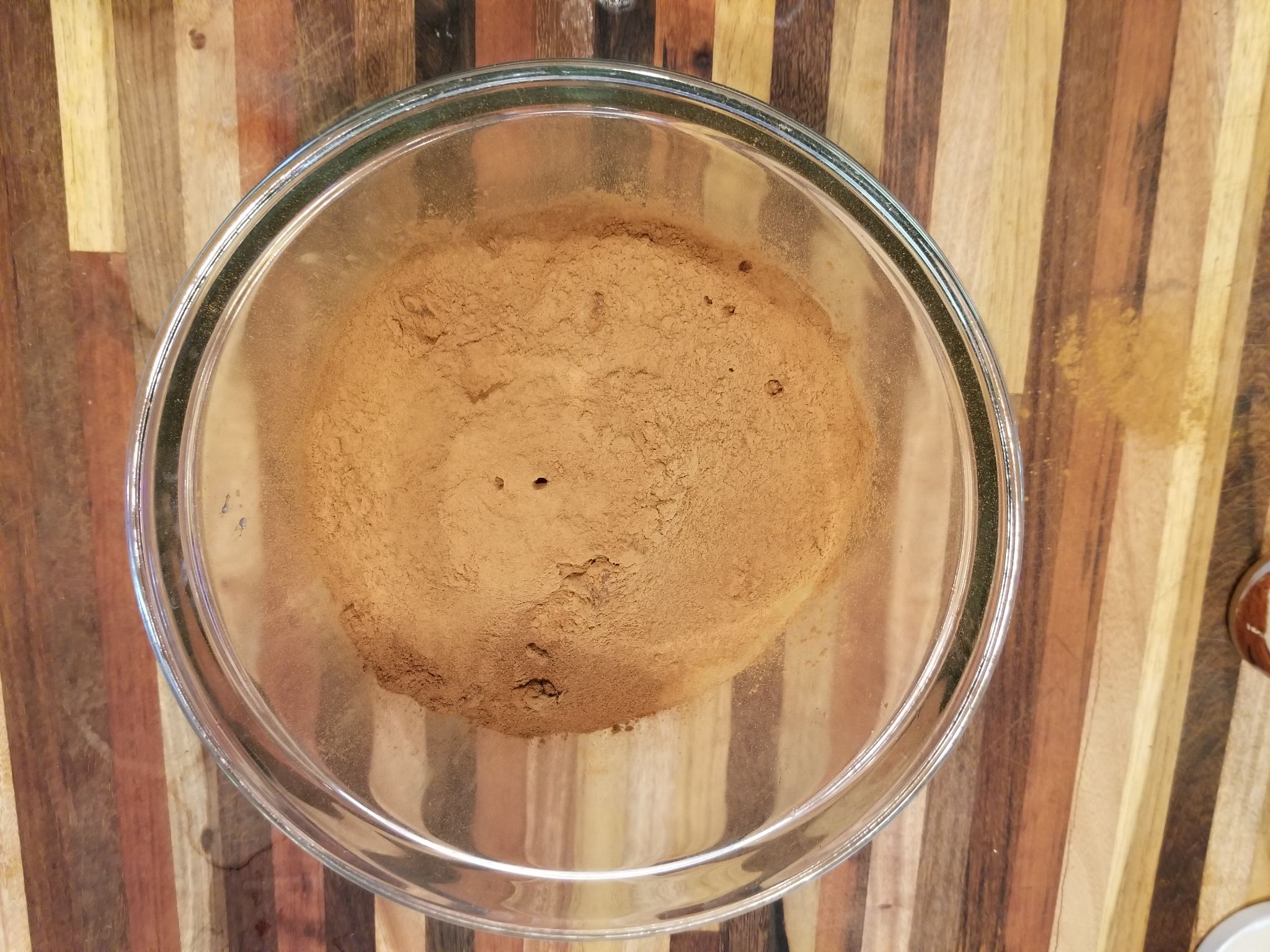
Step 3: Add 2 cups of cinnamon.
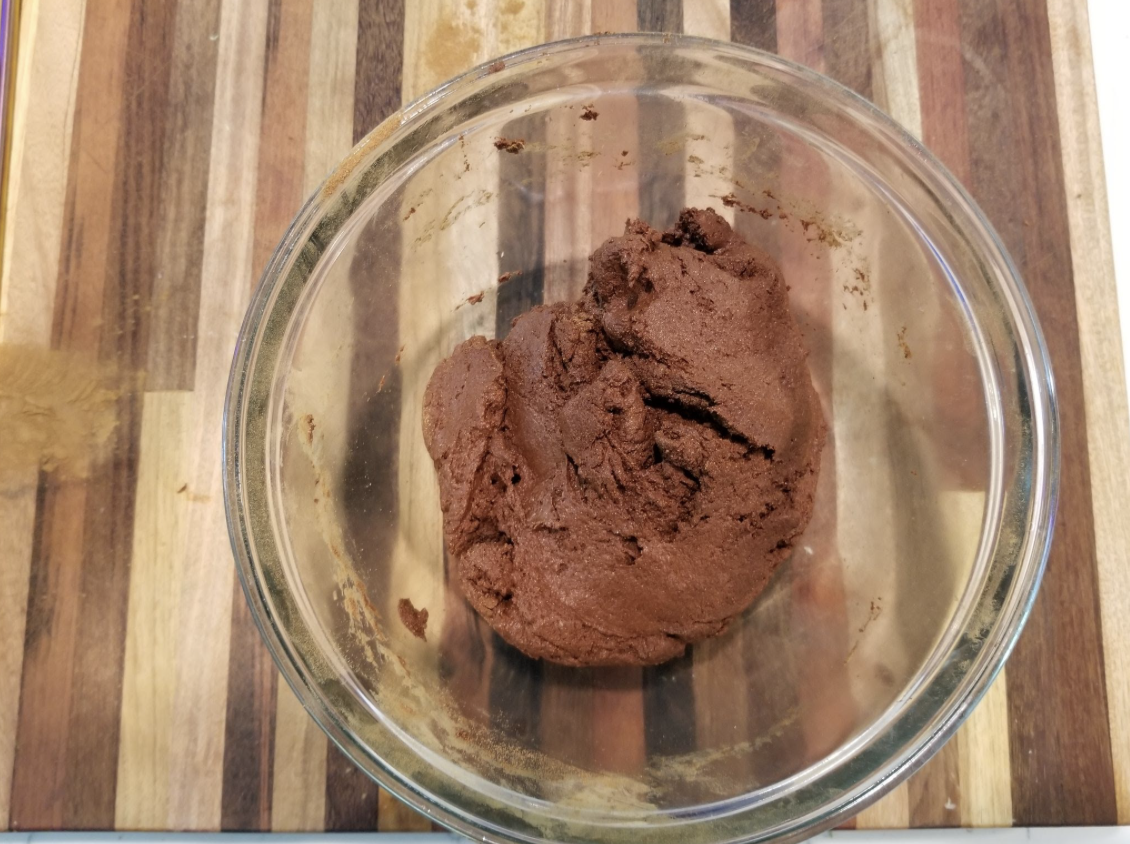
Step 4: Mix it. Form it into a thick ball.
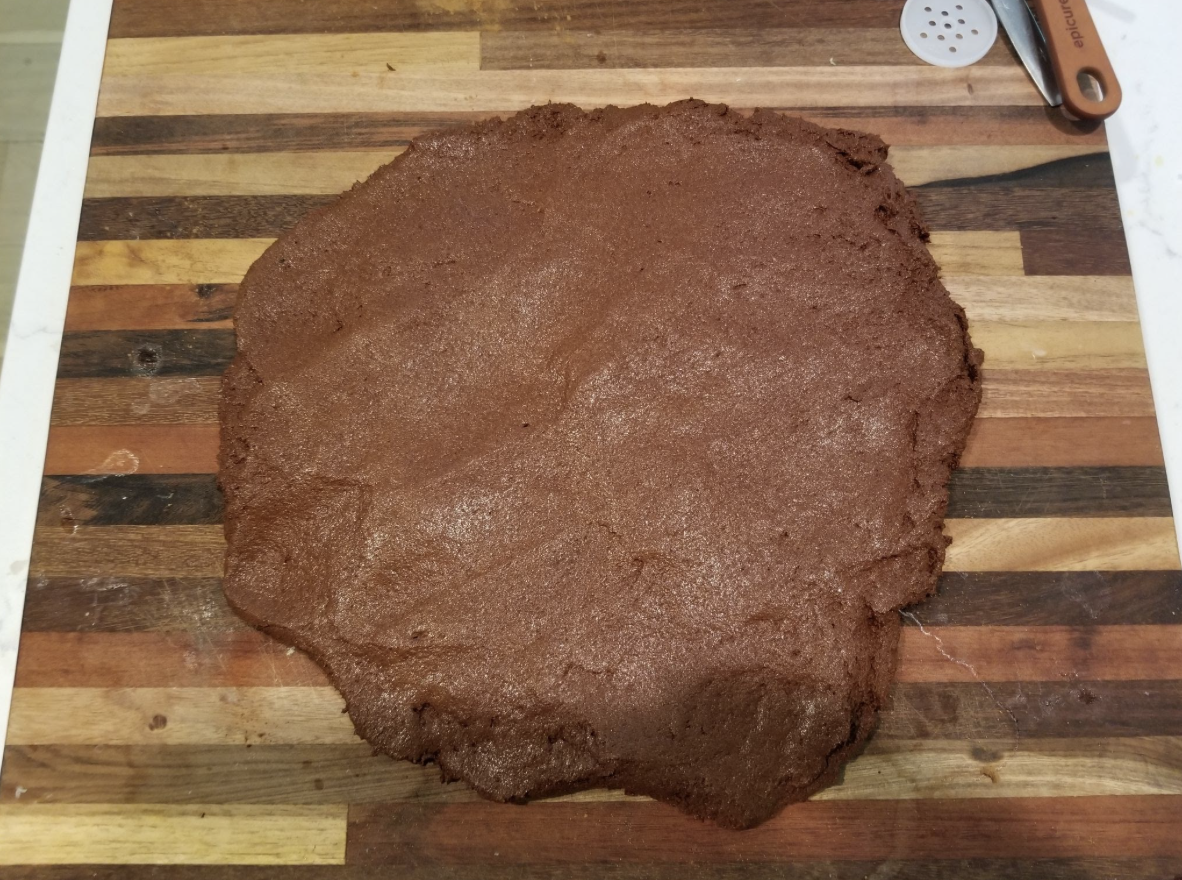
Step 5: Pat it flat.
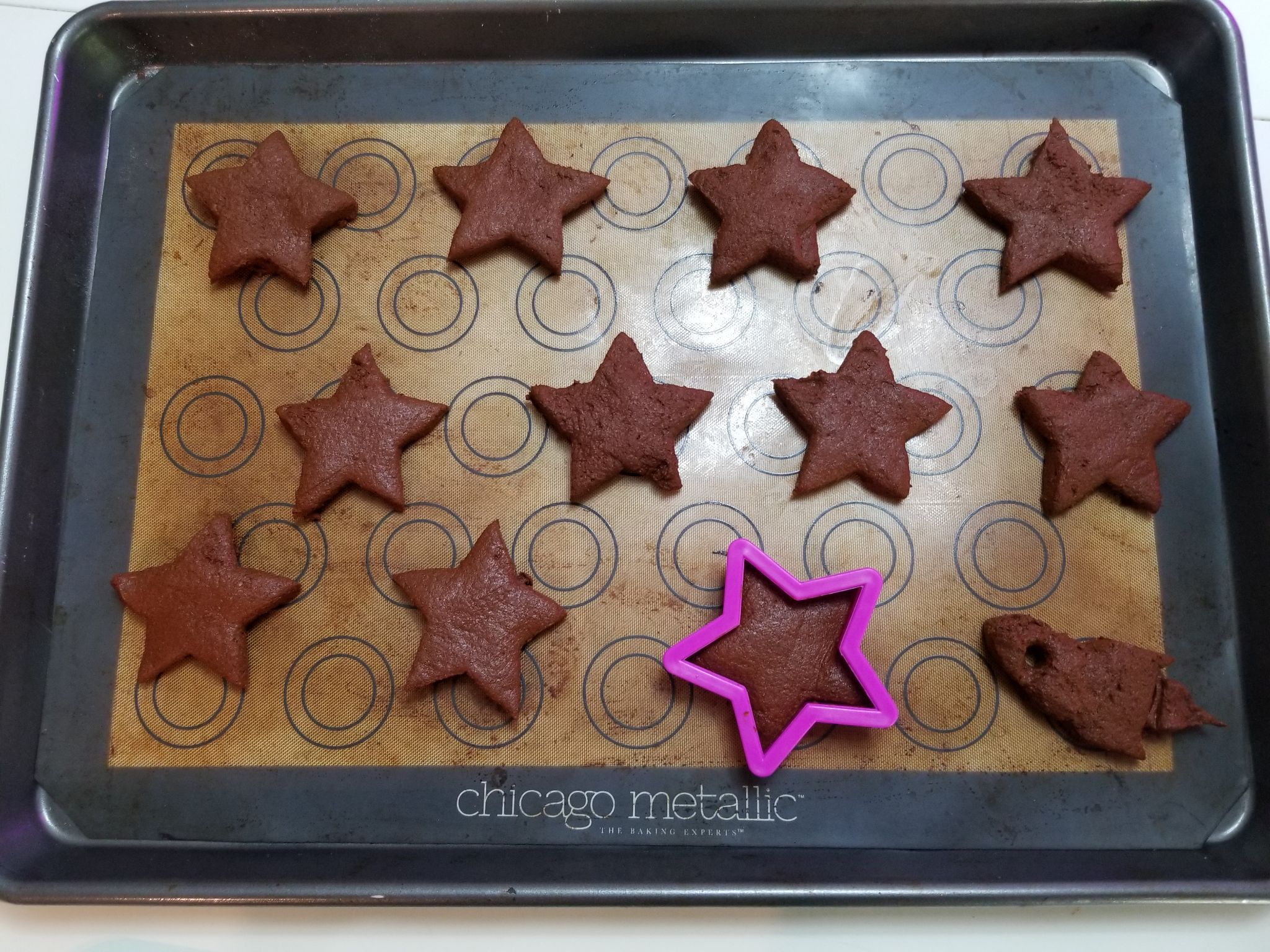
Step 6: Cut out shapes. Put them on a baking sheet.
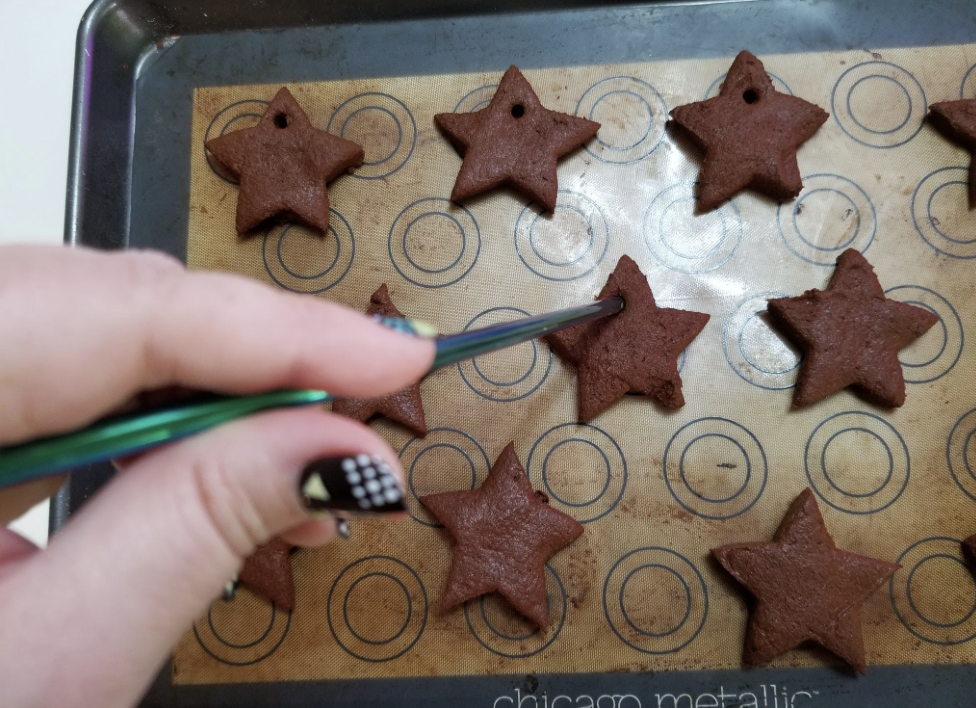
Step 7: Make a hole at the top with a straw.
Step 8: Put them in the oven. Bake for 2 hours.
Step 9: Take them out and let them cool.
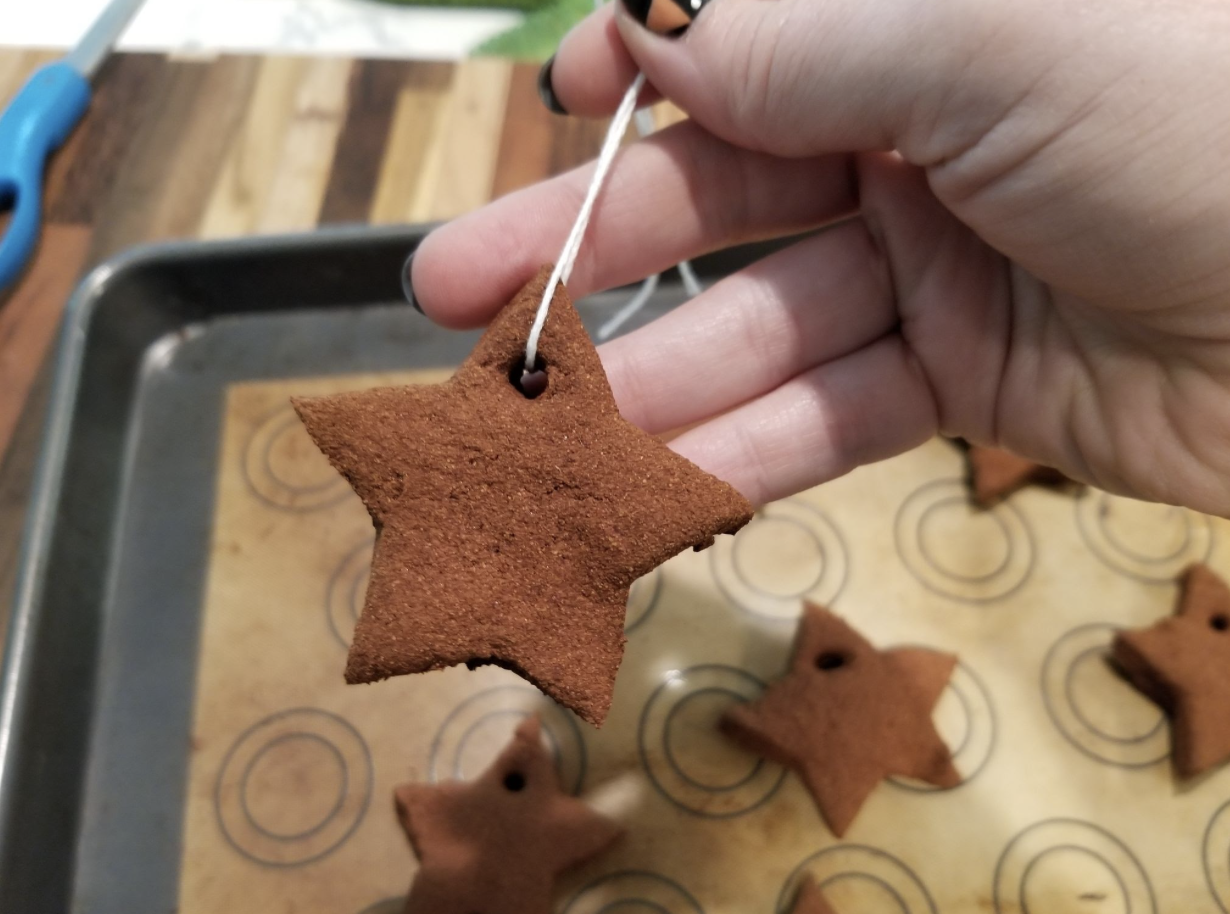
Step 10: Put strings in the holes and hang them up!
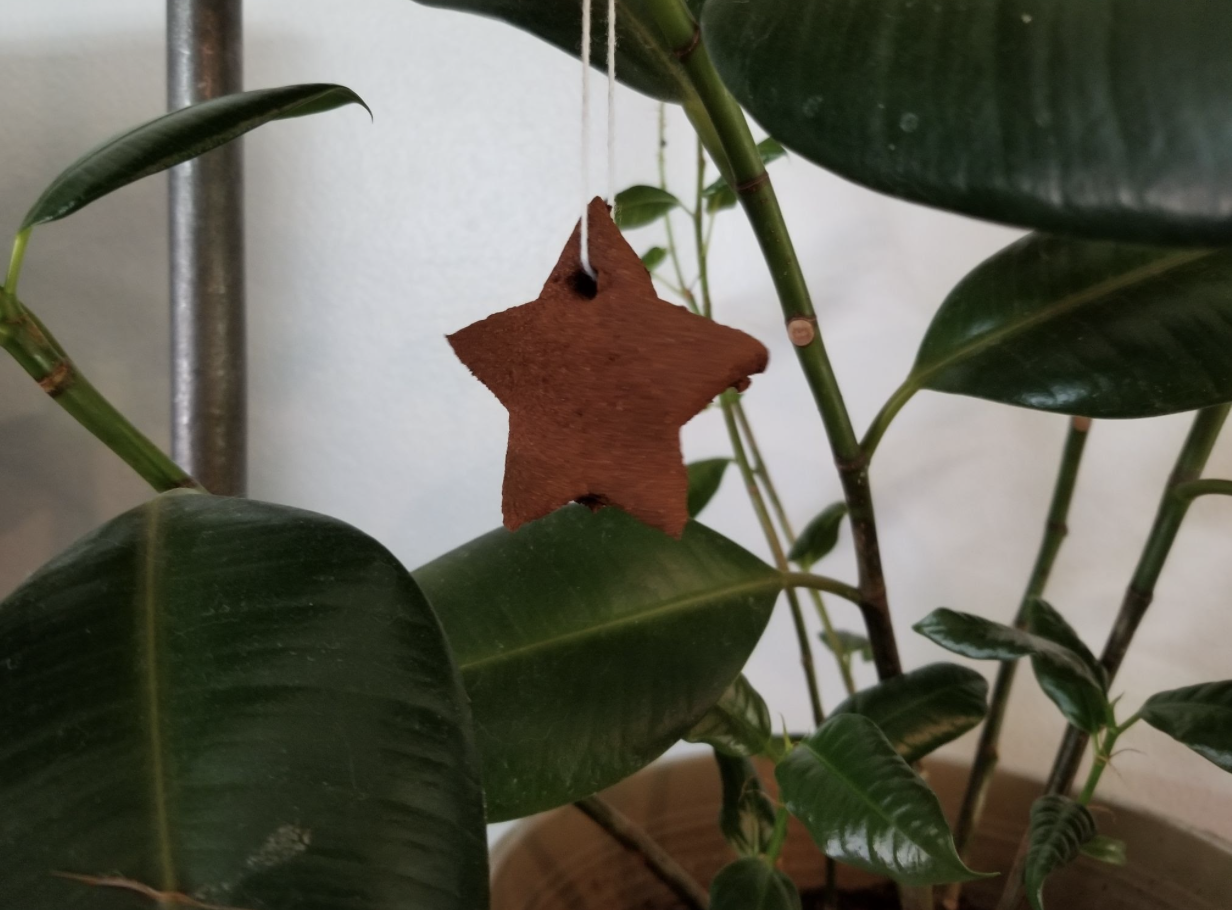
Enjoy!
Tempted to write off empathy as a “soft” skill? Think again. Today, understanding and being sensitive to others’ feelings and perspectives is seen as a new “superpower” across fields from education and business to science and technology. And it’s credited with everything from increased personal satisfaction and creativity to better leadership and negotiation skills. As Barack Obama put it, “Empathy is a quality of character that can change the world.”
But empathy is on the decline. The U.S. is suffering from an “empathy deficit,” according to researchers. In 2009, American college students were found to be less empathic than 75 percent of those 30 years earlier (and the jury’s out on whether things have improved since). It appears that as a society we’re becoming more narrow-minded, more disconnected. Yet only around 10 percent of our ability to empathize actually comes down to genetics, while making a habit of it—for example practicing loving-kindness meditation—can make our brains grow. Knowing all this, perhaps there’s a case for including empathy in school curriculum, as Denmark has done since 1993.
Want to nurture empathy? Love literature? You’re in luck. According to experts and organizations such as Empathy Lab, reading fiction increases empathy. But how does immersing yourself in a story help make you a better person? And how might this be relevant for your child and your family’s reading choices?
In this article, we take a look at the research, and how—among many other benefits—fiction helps us and our children to develop emotional intelligence.
Fiction Helps Kids Understand Other People’s Points of View
In psychology, Theory of Mind is the term for the ability to understand and think about what another person is thinking and feeling—a kind of “mind-reading,” albeit one most of us practice regularly. A skill closely associated with empathy, it truly starts to emerge in children around age four or five. The good news for little fiction readers? One study has found that preschoolers who are exposed to storybooks are better at it. And another found that the more often children read picture books with their parents, the better their theory-of-mind development.
This link between reading fiction and theory-of-mind is supported by research in adults, too. In one study, fiction readers were found to perform better across a range of social intelligence and theory-of-mind tests, such as the “Mind in the Eyes” test, where participants have to correctly identify complex emotions by looking at photographs of people’s eyes.
But, when it comes to being able to understand what’s going on in other people’s heads, does the kind of fiction you read make a difference? Some evidence suggests so. One landmark study of five experiments shows that adult readers of literary fiction—which tends to be more character-focused, psychologically complex, and ambiguous than other forms—possess greater theory-of-mind abilities than those reading nonfiction, popular fiction, or nothing.
Fiction Lets Kids Feel What Others Feel
Understanding how others may feel at a rational level, known as cognitive empathy, is one thing. But being able to identify with their feelings, at least to some extent, is what takes emotional intelligence (often shorthanded as “EQ”) to the next level. And this is where the ideas that reading fiction can foster empathy—and that it’s possible to harness that empathic uptick to create positive social change—come into their own. For example, some research shows that those who are most emotionally transported by a story are also the ones most likely to behave in a more empathic and pro-social manner.
As with the research connecting reading fiction and theory-of-mind, some studies have found that it’s the stories reflecting greater social, cultural, and psychological complexities that are best for building empathy. In one, children, teens, and university students who read Harry Potter (a body of work depicting a world “characterized by strict social hierarchies and resulting prejudices”) were shown to have less discriminatory attitudes towards stigmatized groups, such as immigrants, refugees, and the LGBTQ community.
But how much can you really put yourself in someone else’s shoes through reading their story? In one experiment, researchers took functional MRI scans of fiction readers’ brains to find out. They discovered that there was enhanced brain connectivity in areas associated with movement and bodily sensation, even several days after reading sections of a novel. This surprising finding suggests that reading fiction increases empathy partly by transporting us into a character’s experiences at a deep level. As neuroscientist Gregory Berns told Psychology Today, “At a minimum, we can say that reading stories—especially those with strong narrative arcs—reconfigures brain networks for at least a few days. It shows how stories can stay with us. This may have profound implications for children and the role of reading in shaping their brains.”
Fiction Opens Kids’ Minds
Reading fiction broadens horizons, taking us to places and scenarios a world away from our own experiences—and this is especially true for younger readers who may have more limited life experience. Plus, when it comes to reading and emotional intelligence, the mind-opening effects of fiction are relevant where empathy is concerned, too.
To truly empathize with others, we must be able to keep an open mind and withhold judgement. But our brains are often driven to find concrete answers, especially in the face of uncertainty and ambiguity—something psychologists call needing “cognitive closure.” One study has shown that reading fiction reduces the need for cognitive closure, exercising the brain’s open-mindedness and stretching our ability to tolerate ambiguity. Even better? The effects are more noticeable the more often you read.
So, next time your child asks you to read them a story, just think: not only are they opening themselves up to the joys of reading, they’re also opening their heart and mind in ways we’re only just beginning to understand. Talk about the power of reading.
Can you remember stories from childhood that sparked your empathy or opened your mind? Tales that had you grabbing the tissue box in sympathy? Let us know your favorites!
By Chrysta Naron
Many kids can sing the ABC song before they can speak in complete sentences. This is great—children should be exposed to the alphabet and will eventually need to know alphabetic order.
However, singing the alphabet only teaches letter names. Unless you’re pointing out written letters one by one as you sing, the alphabet song is just a song. Kids aren’t learning anything about what the alphabet indicates in print. And the song doesn’t even teach all the letter names particularly well, since many of them blur together in singing. (Elamenopee, anyone?)
Committing the ABC song to memory is still worthwhile, but it’s important to realize it’s only one small part of what toddlers and preschoolers should be learning. When you think about helping your little one learn their ABCs, it pays to mix things up. Expose them to letters on their own, as part of the alphabet (both verbally and written), and as part of words.
You can make sure your child learns the individual letters by bringing attention to them regularly in your daily life, in books, on signs, in names, and all around you. Below, you’ll find some tips, plus fun and easy alphabet games and activities to teach the alphabet at home.
Follow Your Child’s Interests
Many parents start by pointing out and teaching their children the letter that begins their name. This makes perfect sense. Your child will be excited and proud to know “their” letter. As for where to go from there, keep in mind your big advantage as a parent teaching your child: You can individualize your approach and respond to your specific child. So, you can follow up the letters in their name by pointing out other letters that are important in their environment or, as they know more of the alphabet, by focusing in on letters they don’t know yet.
Teach the ABCs Through Play
Keep your letter learning fun and casual, just mixing some ABC practice into daily activities, conversations, and games. You can even pick a letter to practice each day. (But don’t worry: Just keep this up as long as it works for you.) You and your child can practice writing the letter (on paper or write “tactile letters” with your finger through various substances), make the letter out of playdough and popsicle sticks, and look for the letter throughout your day. But rather than go in alphabetical order, remember the tip above.
Get Spontaneous and Mix it Up
Once your child is on their way with some key first letters, you can also let spontaneity be the way your child discovers more letters of the alphabet. For example, you can ask them to close their eyes and point to a letter. When they open them, have them name the letter they’re touching. If you’re a family that uses flashcards, simply make sure to shuffle the cards up before each use. (For a fun variation on typical flashcard study, use your flashcards to play Alphabet Game of War!)
Easy At-Home ABC Games & Activities
Ultimately, the best way to teach the alphabet is little by little, over a long time. Point out letters, write them with your child, talk about them, and play with them. No need to wear your child (or yourself) out: Just mix in a little alphabet talk and play into the rest of your lives together. See MayaSmart.com’s literacy activities for lots of fun games and crafts that introduce and reinforce letter learning: You can go fishing for letters, make some no-bake letters, or play a game of ABC bingo. Or get moving and play alphabet hopscotch with your little one.
And when it comes to learning letters, remember it’s progress, not perfection. Your child doesn’t need to get every letter right on every single try in order for them to be doing well. Just keep practicing and playing, and soon they’ll have them all down!
What’s working for you to teach your child the alphabet? Share with us in the comments!
This craft takes advantage of seasonal enthusiasm to build your child’s vocabulary and help them learn to recognize, read, and spell new words. Fun holiday words, that is, of course!
With our free Christmas alphabet printable, you’ll make an adorable flipbook to keep or gift. (Tip: It makes a super-cute stocking stuffer or a fun present from an older child to a younger one.) The flipbook is easy to make, you can use it time and again, and it’s a great way to teach young children new Christmas vocabulary. For fun ways to engage your child with their flipbook, see the end of this post.
This free Christmas alphabet printable consists of twenty-six seasonal words and illustrations from A to Z. It also includes a flipbook cover where you can write your child’s name. Happy Holidays!
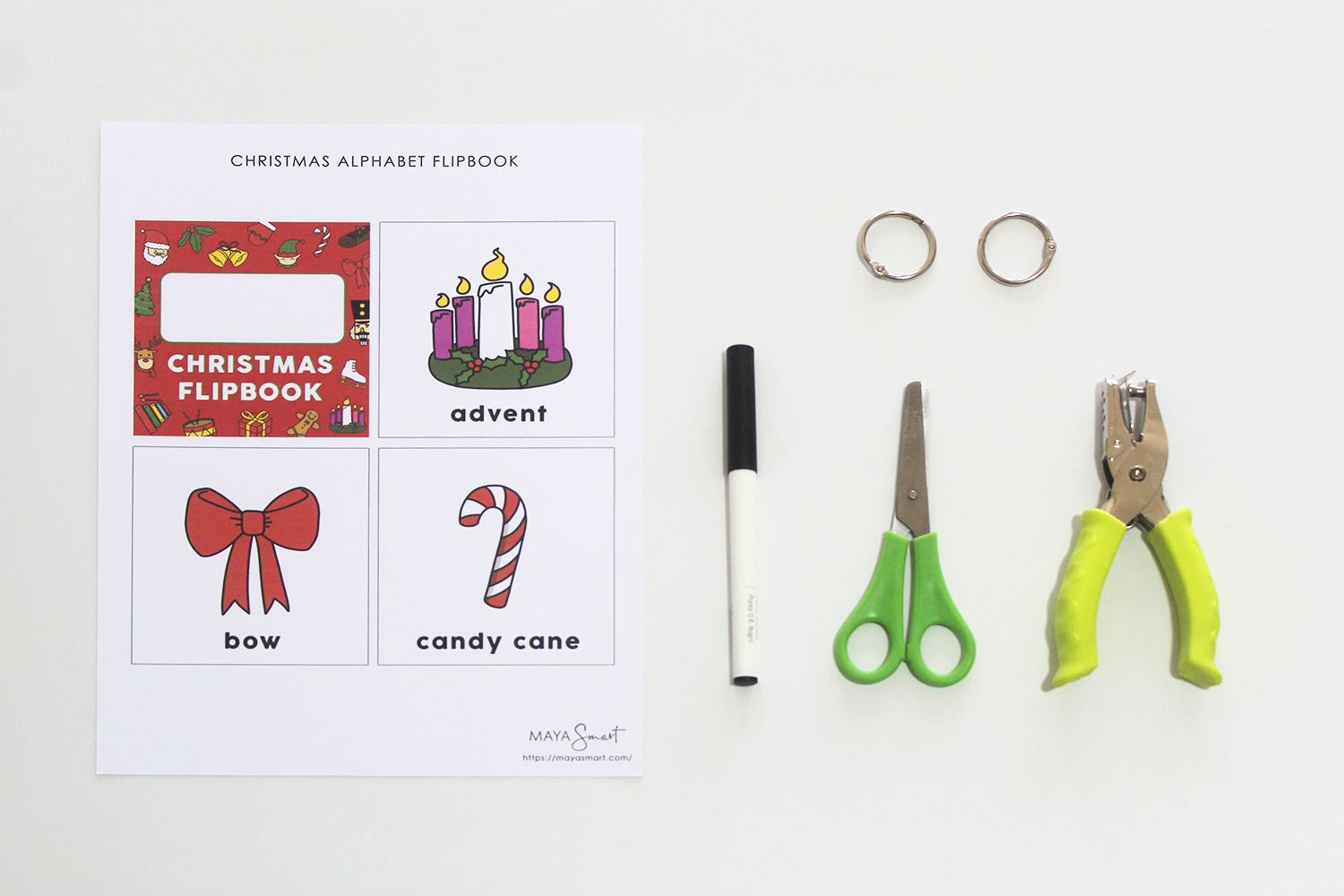
Materials:
- Printer
- Cardstock paper (7 pieces) or normal paper + cardboard
- Ring-binder clip (2 pieces) or string/ribbon
- Scissors
- Hole punch
- Pen or marker
- Laminating sheets (optional)
Step 1: Begin by printing out your free Christmas alphabet flipbook template on seven pieces of cardstock. Cardstock is thicker than regular paper, which makes it perfect for flipbooks.
Tip #1: If you have no cardstock available, you can print the template on normal paper and glue it onto cardboard.
Tip #2: You can also print the template on normal paper and laminate it. (Use self-laminating sheets if you don’t have a laminator.) This will make your flipbook waterproof and more durable!
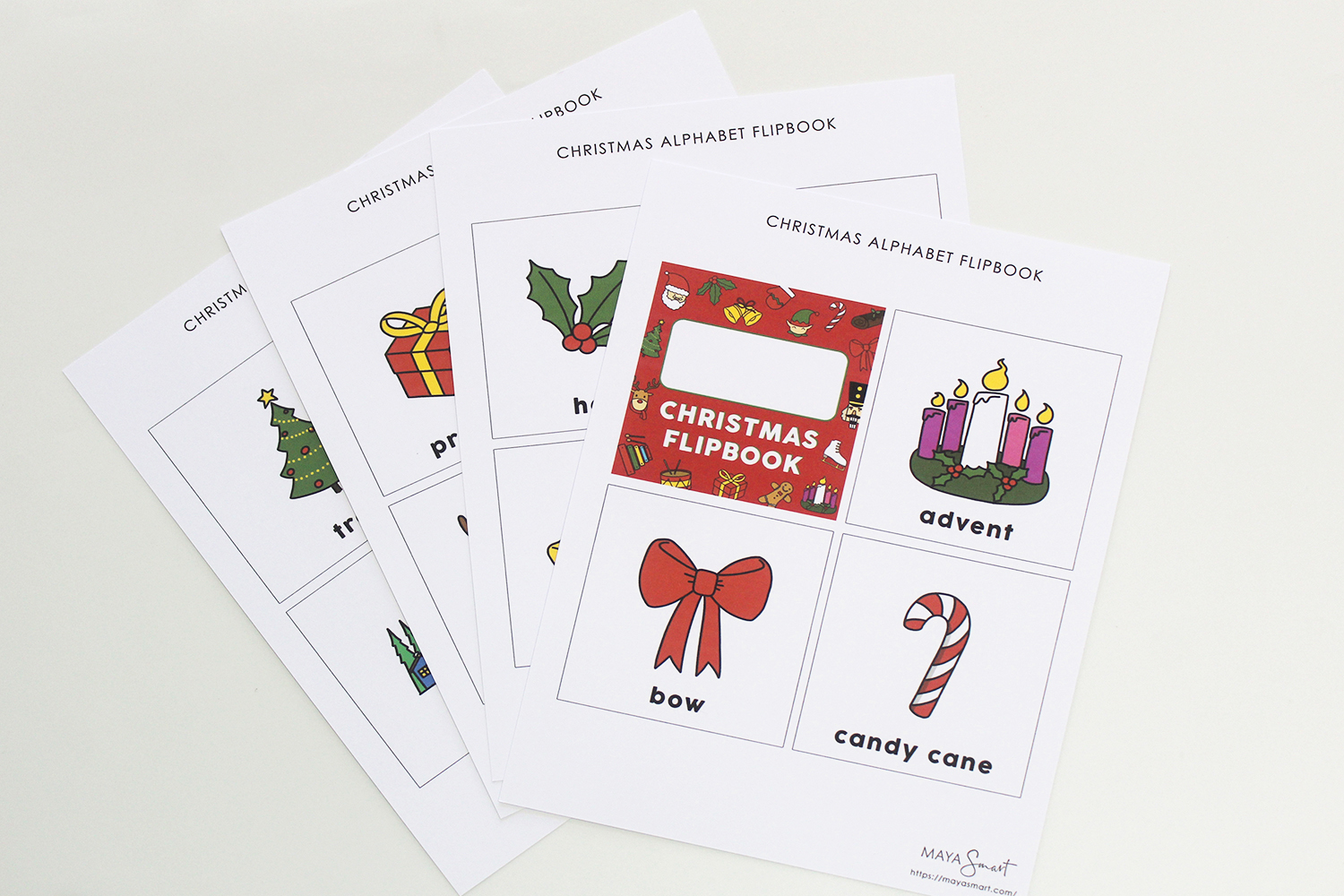
Step 2: Next, cut out the template. You can also invite your child to cut out the cards since the lines are straight. It’s great practice for their fine motor skills in using a pair of scissors. Of course, supervise your child during cutting.
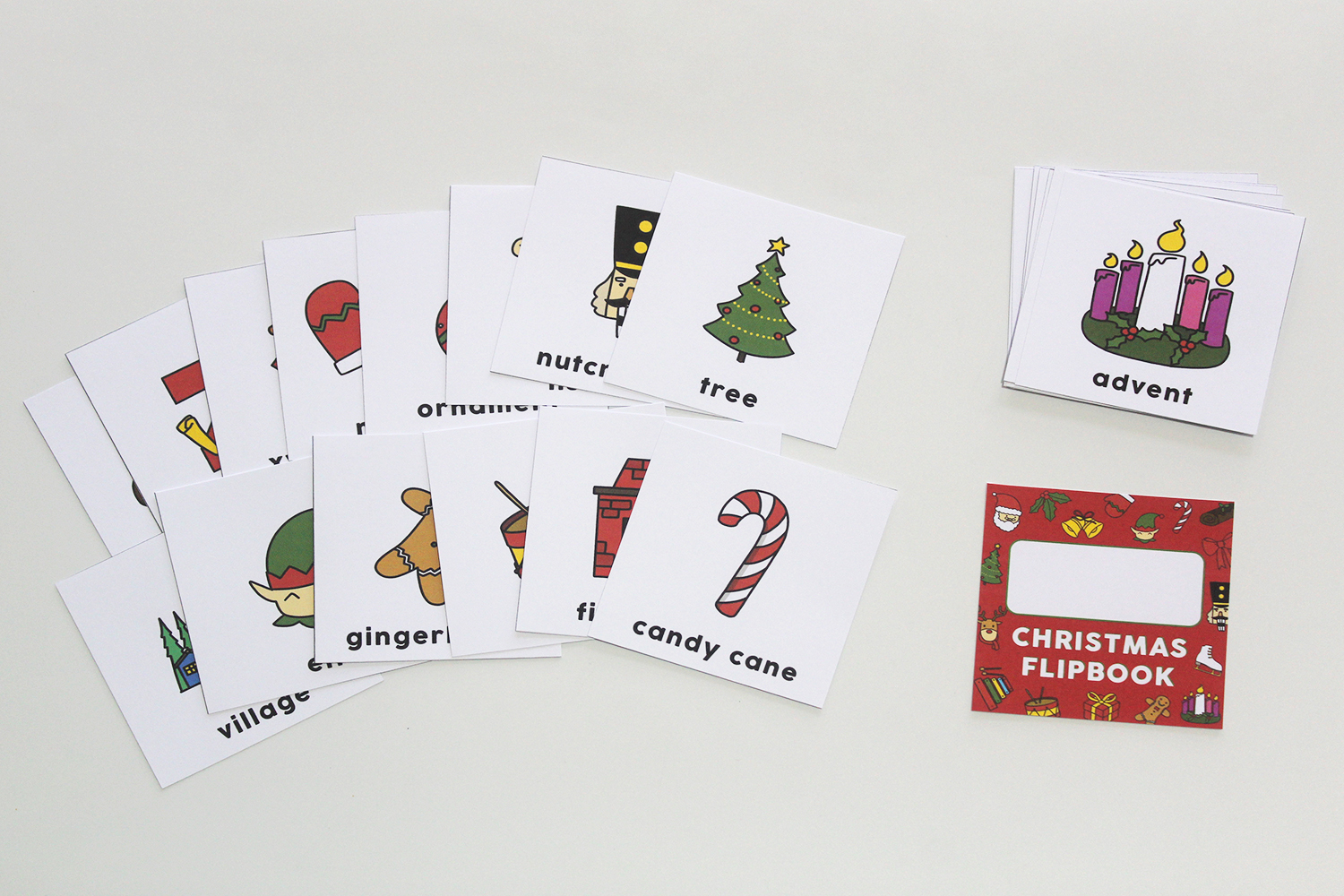
Step 3: Then you need to punch two holes on each card. Make sure the holes are placed in the same position on all cards.
Tip: You can place one card with hole punches carefully over another card and trace the holes on the top card onto the bottom card to ensure placement.
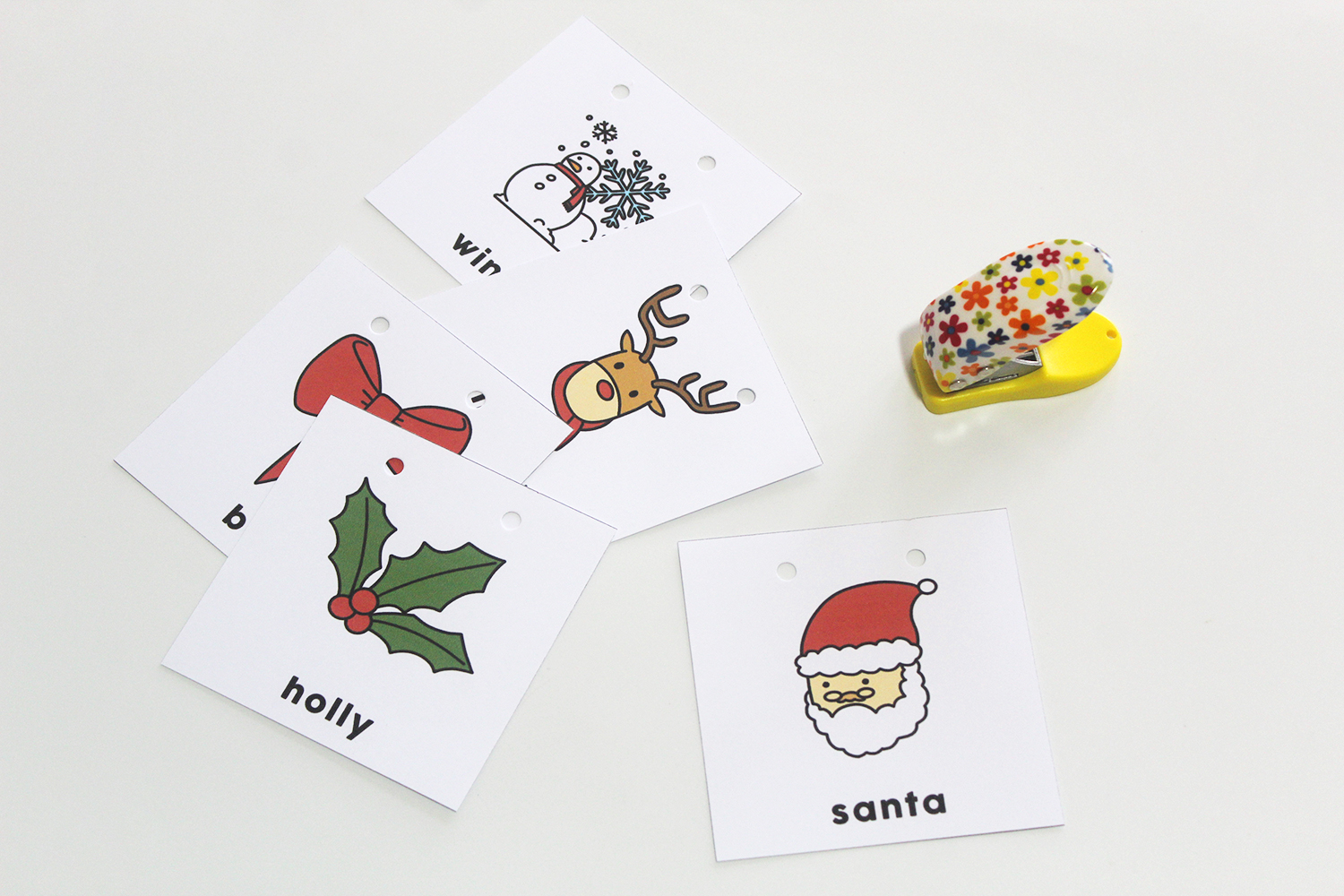
Step 4: Alphabetize the cards and put them into a stack that goes from A-Z.
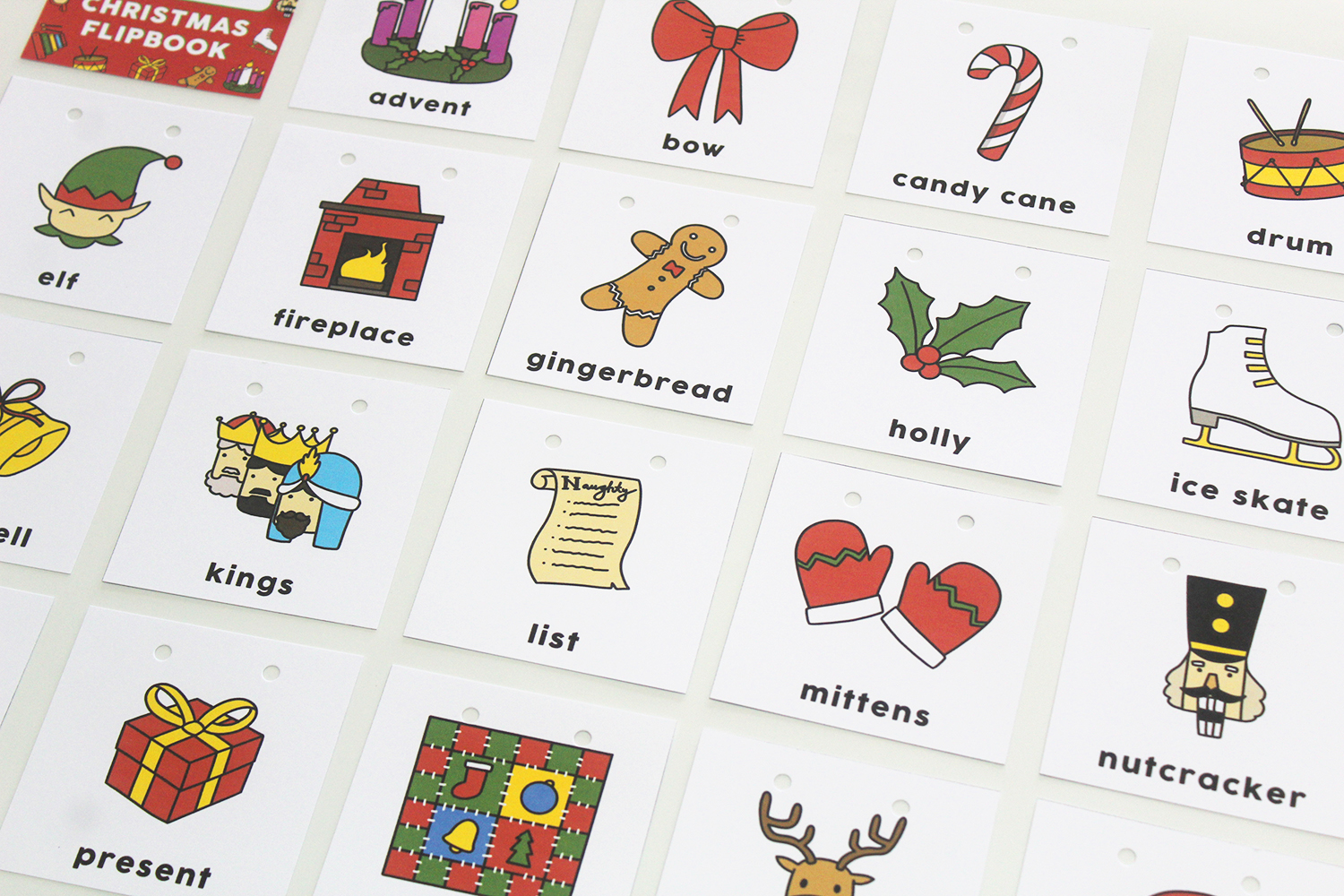
Step 5: Insert the ring-binder clips into the two holes in the stack.
Tip: If you don’t have ring-binder clips at home, you can use a piece of string or ribbon to tie the cards together.
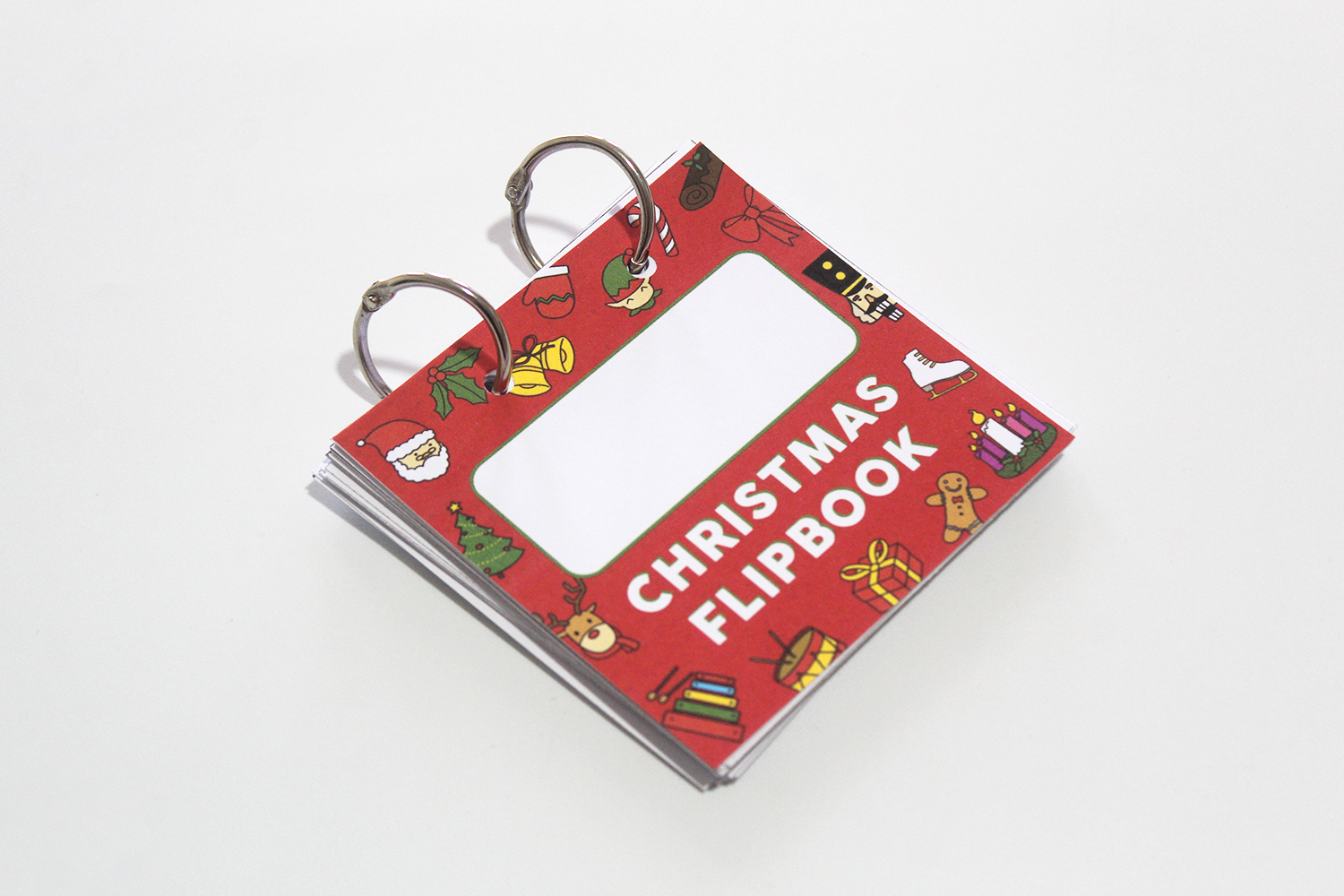
Step 6: To make the Christmas flipbook more personal, write the name of your child on the cover page. You can also help your child to write their own name.
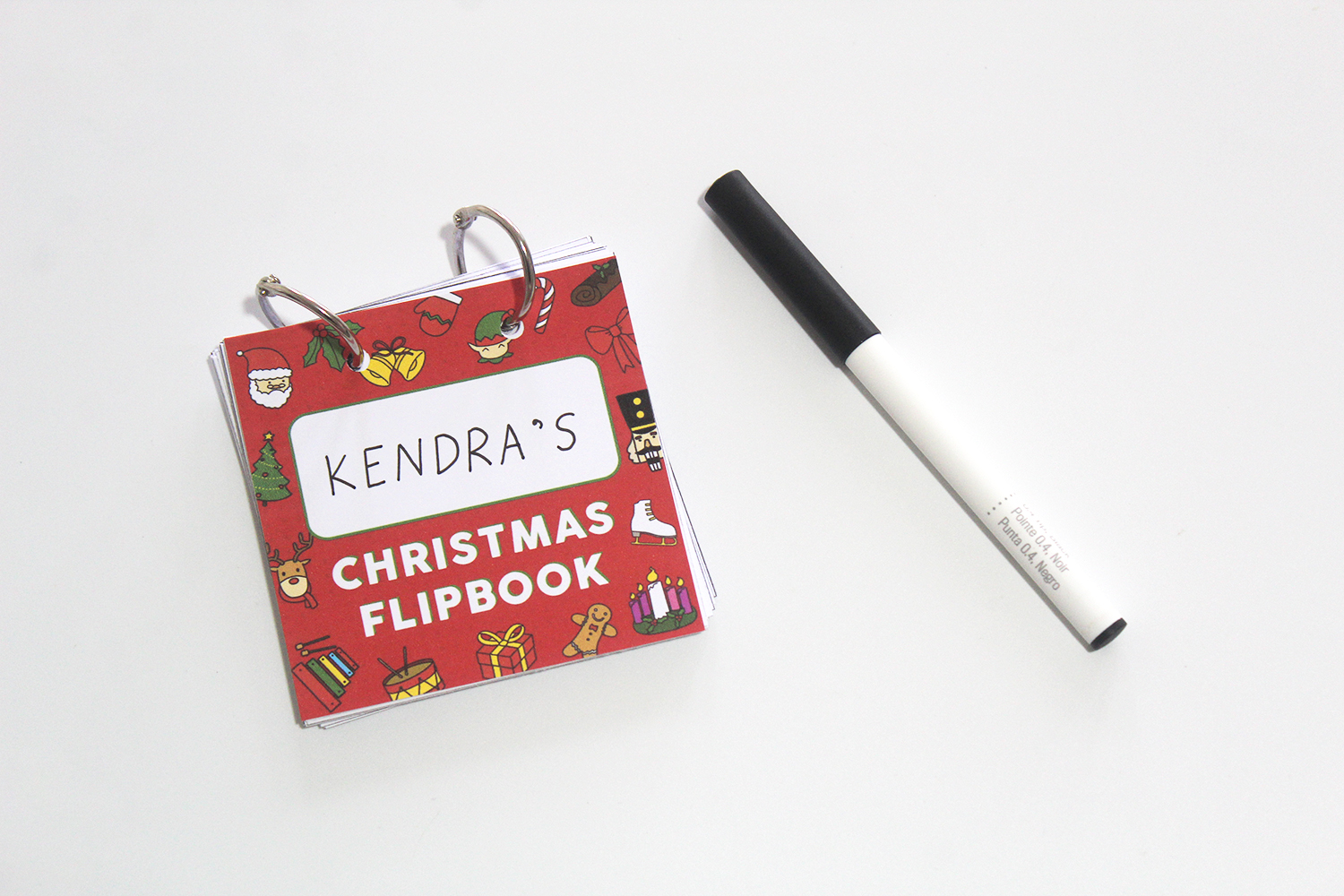
This Christmas alphabet flipbook is great for a variety of ages. For younger children, you can use the flipbook to introduce new Christmas vocabulary and practice reading the words. For older kids, you can ask them to write a sentence using the Christmas-related words in the book, or use them as prompts for storytelling. Play around with flipping to random pages and making up a story or silly sentence based on the word on that page, for example. Have fun!
We’d love to see how your craft turned out! Feel free to connect with us on social media to share some pictures!
December is creeping closer, bringing its flurry of wonderful winter holidays! With those holidays come beloved traditions—favorite dishes, decorations saved and hung year after year, and stories to be told. Every family has their personal favorite tales and books (The Night Before Christmas is a staple in our household, like so many others). Traditions are a wonderful part of the holiday season. But what if, this year, you added some new books to your mix, to become new traditions, too?
How would you know which books to choose? If you look at many of the classic American Christmas books, they’re written by white authors. Christmas is a holiday that includes families of every race and ethnicity, so shouldn’t the holiday books we read our children? Black children deserve to see themselves in books and stories, and non-black children need to see how Christmas in the United States truly looks. There are so many incredible Christmas books by black authors, so we’ve curated a list of eight favorites, plus some other lovely winter holiday books by black authors, for you to add to your reading traditions.
The winter holidays are a time for love, warmth, and togetherness. And what better way to celebrate those things than to get snuggle up cozy with the people you love and read books that bring us all together? You’ll never be lacking in holiday spirit when you pick up one (or all) of these fabulous Kwanzaa, New Year’s, and Christmas books by black authors. Who knows? You might even find yourself reading them all year round.
Is there any sport quite as universal as the game of soccer? Whether you call it football or soccer, there’s nothing like cheering on your country in the World Cup or yelling Gooooooal! when your favorite player scores.
Like all sports, soccer showcases teamwork, perseverance, and discipline—wonderful qualities to reinforce during read-aloud time. To help you encourage the little players and fans in your life, we rounded up some of the best picture books about soccer. Read on for stories about legendary players, the unifying power of the game, and silly characters that remind us that while sports may be competitive, they’re also a whole lot of fun.
For Pelé fans, add Pelé: King of Soccer/El Rey del Fútbol by Monica Brown to your reading list, too. Rudy Gutiérrez’s bright, fanciful illustrations spill off the page and immerse you in the life of Pelé, aka the King of Soccer in this inspiring bilingual picture book.
Note: The book ends with a note to parents and educators with information on how organizations in northern Indian villages are using soccer to combat child marriage, which could serve as an important conversation tool with older children.
Note: References to violence, while not graphic, might make this story better suited to more mature readers, but this read is sure to spark important conversations with your children.
For more soccer reads by Mina Javaherbin, try Goal! or Neymar: A Soccer Dream Come True.
Don’t miss our other sports book lists!
Before we adults learned how to read and write, we were introduced to the 26 letters of the English language. For most of us, our first encounter with the alphabet was singing the ABC song. But the truth is kids need to learn a lot more than to slur letter names together in song (adorable as that may be) to prepare for kindergarten and beyond.
They need to learn what letters look like—and which of the 52 uppercase and lowercase shapes actually indicate the same letter, among other things.
A powerful and fun way to teach your child upper- and lowercase letters is through play. There are a lot of educational toys on the market nowadays, but why add more plastic junk to the world (and shell out cash) when you can make your own homemade educational toys that are just as effective?
That’s why we created this free printable to encourage you to make your own fun, low-waste, and low-cost educational Thanksgiving activity. It’s a DIY turkey letter-matching game that’s easy to put together and designed to teach your child to match corresponding upper- and lowercase letters.
Our printable consists of a cute turkey page with lowercase letters and a page of turkey feathers with uppercase letters. It also comes with a black-and-white version of the printable for easier printing, so don’t stress if you’re low on ink. Have fun!
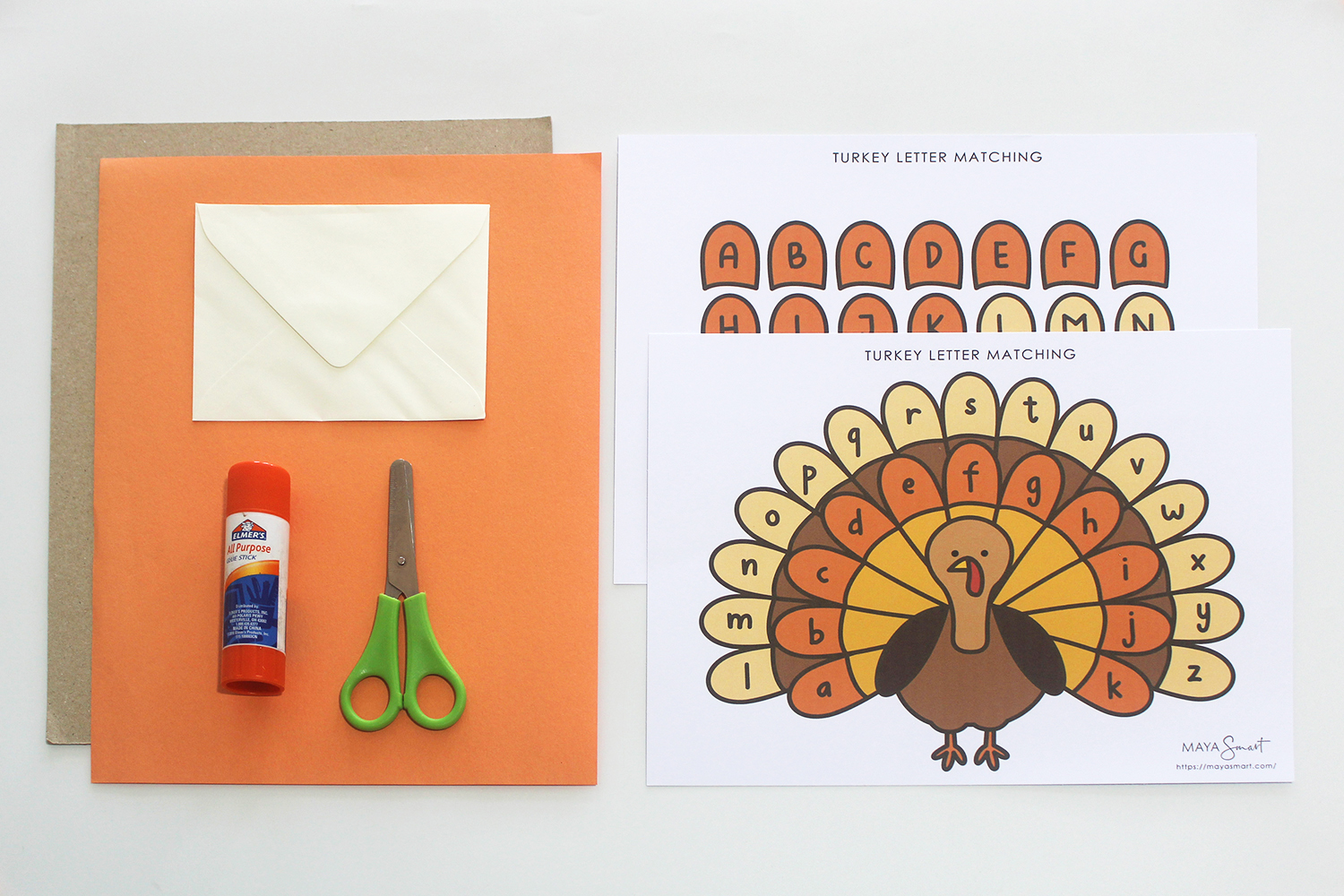
Materials:
- Printer
- Cardstock paper (2 pieces) & colored paper (1 piece)
- Envelope
- Scissors
- Glue
- Cardboard cut to the size of letter paper (optional)
- Contact paper / laminator (optional)
Step 1: Enter your email above and then check your email for the PDF! Choose our full-color turkey letter-matching game printable or our low-ink black-and-white turkey letter-matching game printable. Then print your template on two pieces of cardstock or regular paper.
Step 2: Next, carefully cut out the letter shapes from the template. (You can also cut out the turkey if you want to put it on a differently colored background, or you can just use the whole turkey page.)
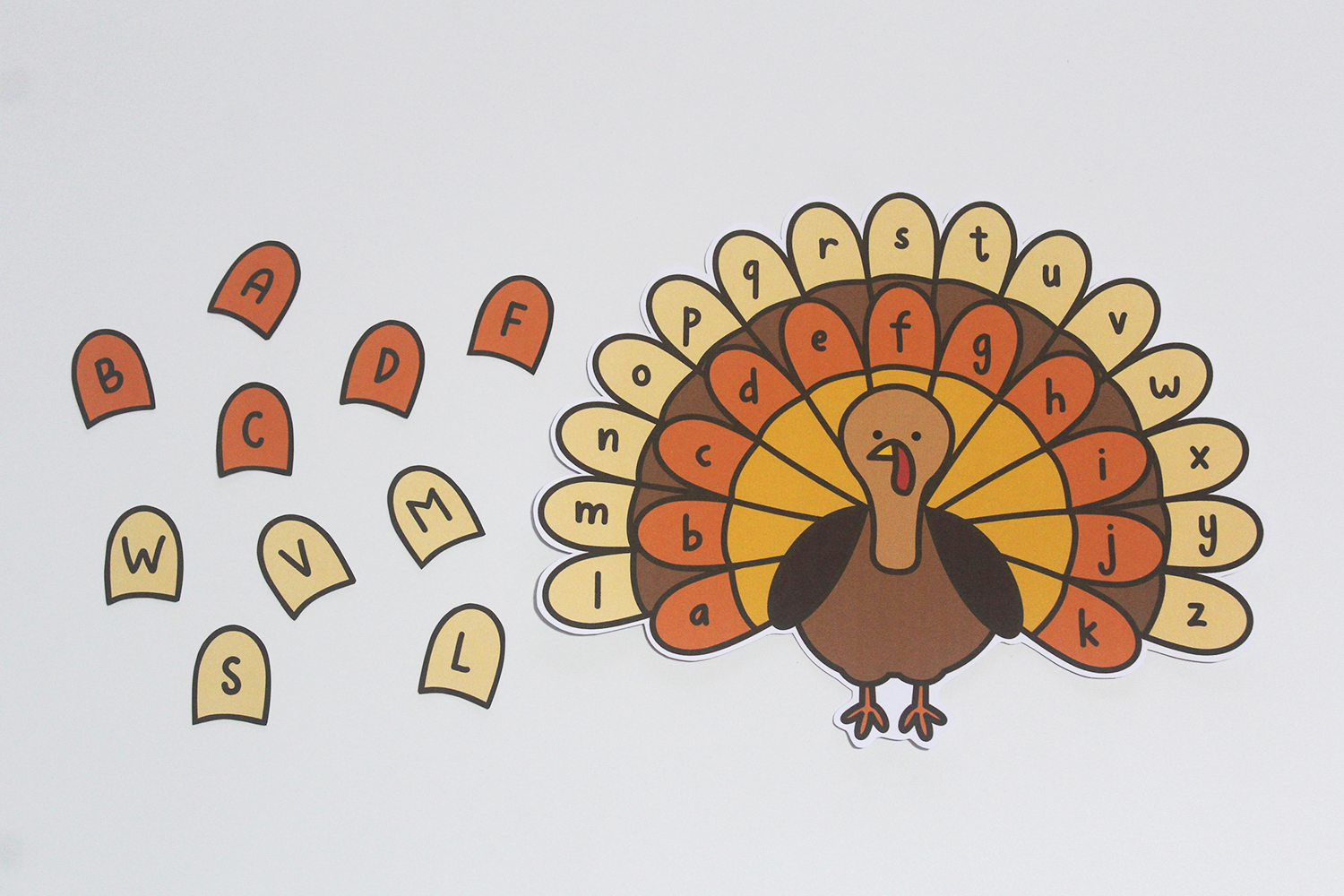
Step 3: To make your game sturdier and have it last longer, you have two options. You can paste your turkey onto letter-sized cardboard (cut some from a cereal box or notebook back) or you can laminate the page in contact paper or self-laminating sheets.
Note: If you decided to use a differently colored background, glue the turkey cutout onto colored paper. Laminate or paste the whole thing onto the cardboard.
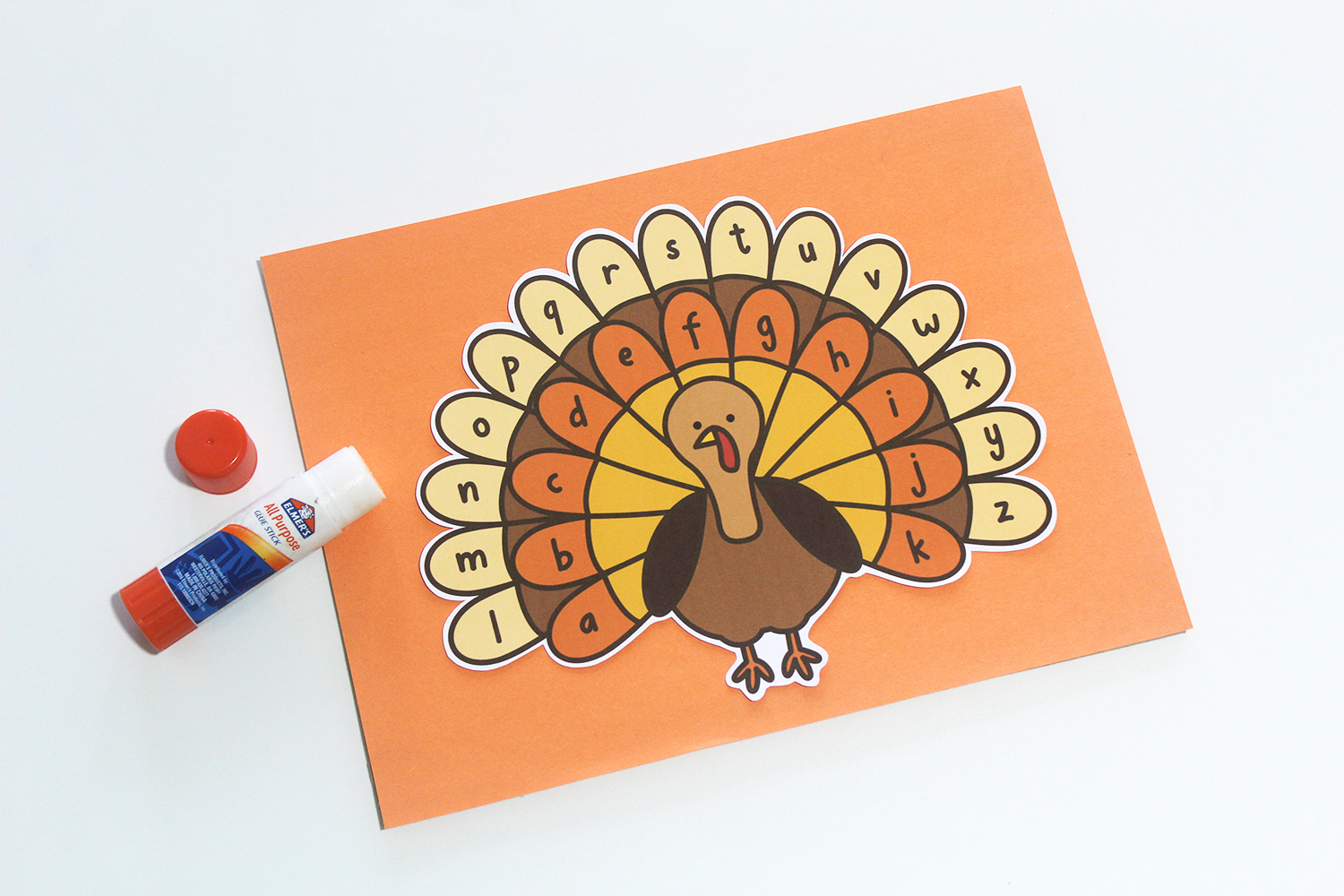
Step 5: Flip over the cardboard or laminated sheet and glue the envelope on the back.
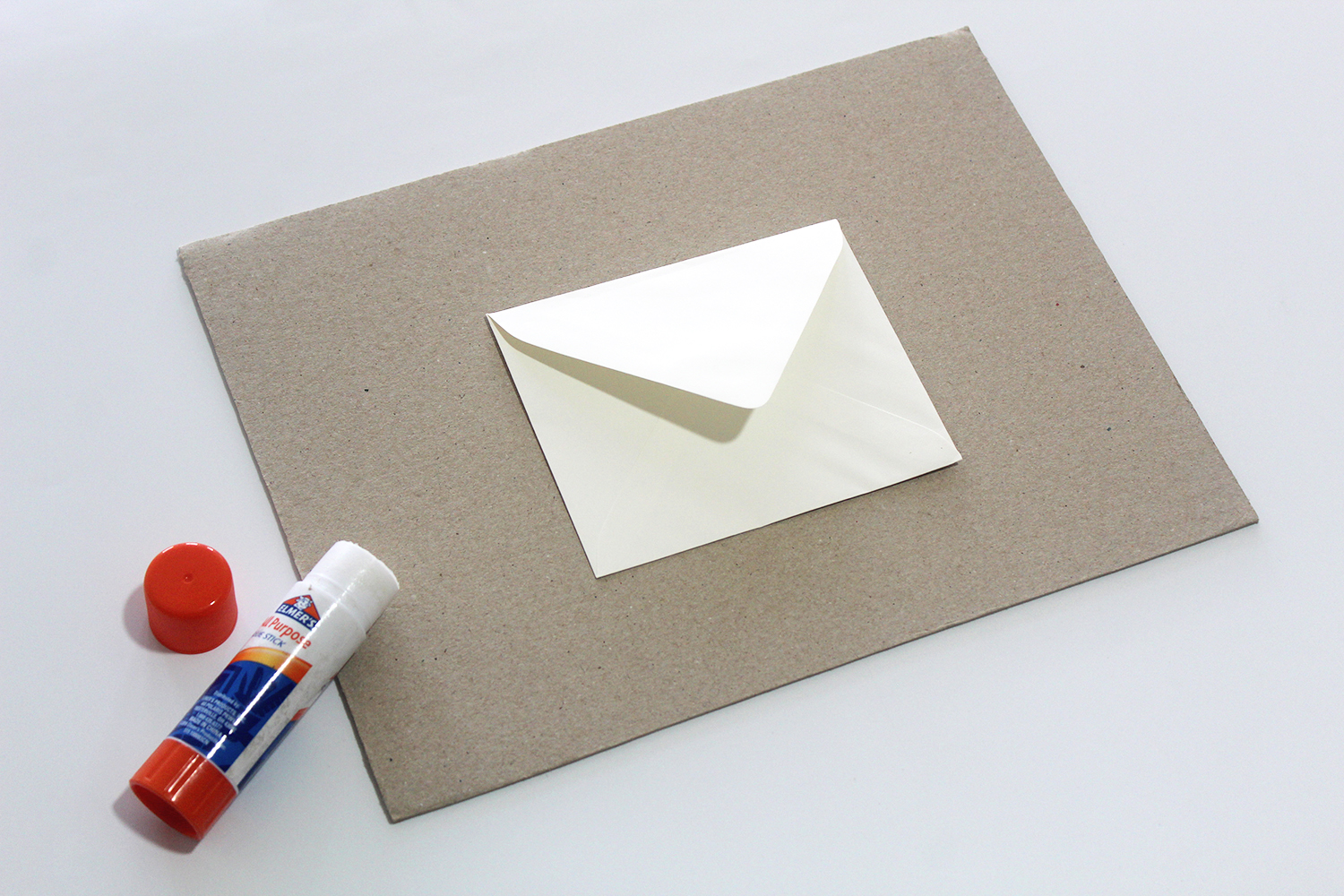
Step 6: If you are not using the game with your child right away, slip the cut-out letters inside the envelope so that they won’t go missing. This way, they are well-contained and are ready to use in your next learning play session.
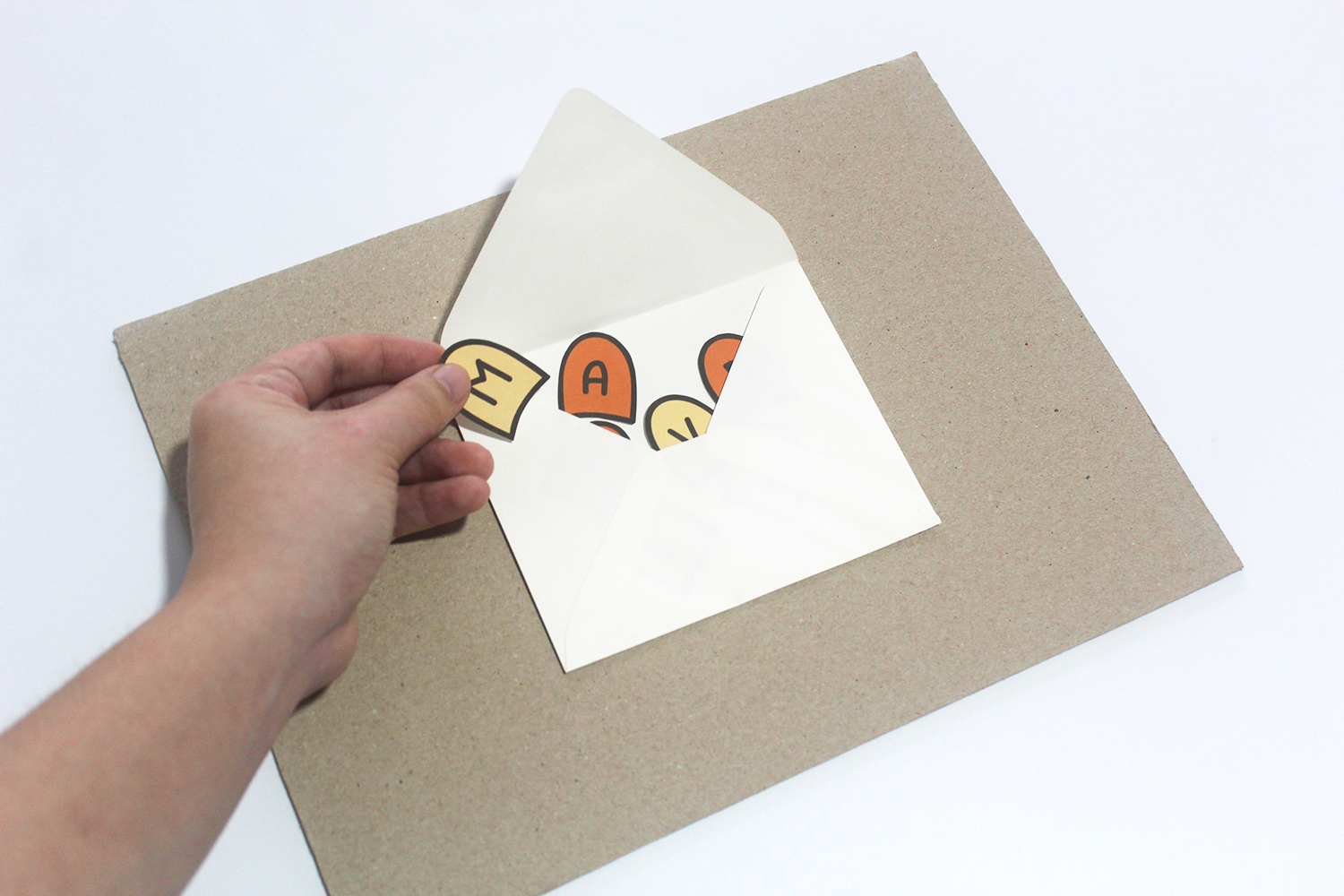
How to play
Now that you are done making your DIY turkey letter-matching game, it’s time to play! Invite your child to identify the letters of the alphabet. Then ask them to see how many upper and lowercase letters they can successfully match together. You can also practice each letter sound while matching the letters.
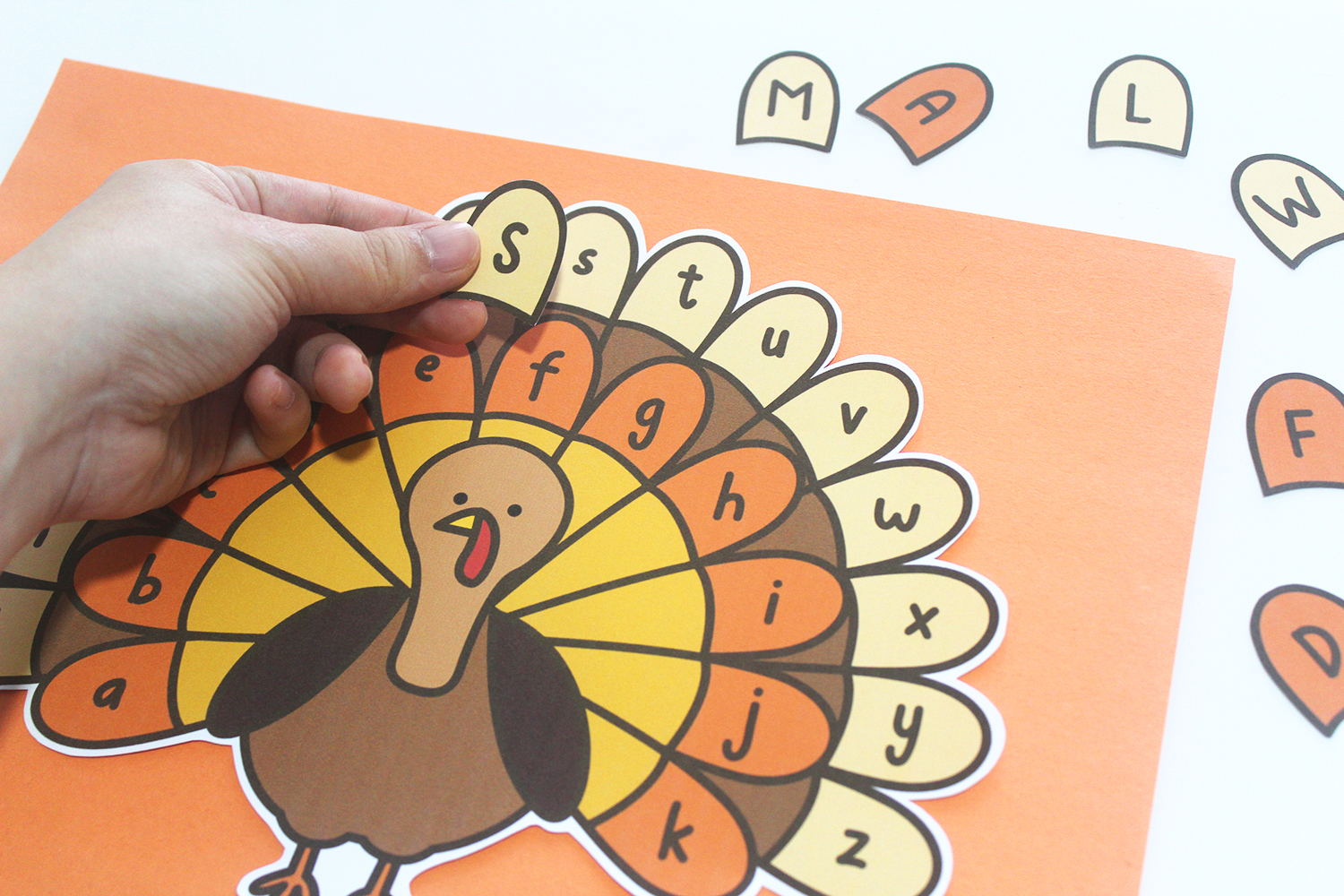
We hope this educational Thanksgiving activity will offer a playful and interactive learning opportunity for you and your child this fall season. Have fun!
For this classic autumn recipe, you can use the seeds from Halloween jack-o-lanterns or Thanksgiving pie pumpkins. They’ll make a yummy snack to keep your little revelers fed, as you model eco-friendly, low-waste living.
Plus, you can use the recipe to help your child practice reading double vowel sounds. To start, enter your email below to get a PDF of this recipe and all our other Read with Me Recipes emailed straight to your inbox, formatted to be accessible for beginning readers.
Print the pumpkin seeds recipe and look at it with your child. Explain that EE can make a long E sound, as in seeds, and OO can make an ooh sound, as in scoop. Next, help your child find and circle all the words with double E or O in the recipe, and then practice reading the words together.
After that, let your child take the lead on reading the instructions, if they’re ready, as you prepare your snack together. Just be sure to help your child with the hot oven.
Note that you can also use the recipe with kids who aren’t ready for reading yet. Just point to each word as you read the instructions aloud. Pause to point out specific letters they may know, or introduce them to letters such as their first initial or a frequent and easily recognized letter like O.
If they have some familiarity with the ABCs, you can ask them to find or circle all the instances of a certain letter in the recipe. (For letter-teaching tips, see How to Teach Your Child the Alphabet: The Ultimate Parent’s Guide.)
Happy Fall!
Tips for teaching kids to read with recipes:
- Introduce your child to how recipes work. If you’re not sure they know them already, be sure to explain vocabulary like “ingredients” and other cooking terms. (Even though we won’t be reading such complicated words in this recipe, they’re important words to learn.) One of the biggest challenges for beginning readers—and most important oral language underpinnings of literacy—is just knowing and understanding all the words they’ll encounter in print.
- Watch out for specific words in the recipe they may not be familiar with, such as “pulp” and “paprika” in this recipe, and give a simple definition.
- For little ones who aren’t reading much yet, just pointing out what you’re reading and emphasizing a few key words or letters is enough. If you make the recipe again, you can help them find the words you pointed out before.
- Use this as an opportunity to show them punctuation, as well as words and letters. Point to the commas, periods, or other punctuation marks, and explain what they mean.
- If they can’t read the recipe on their own, give them chances for success by asking them about what they do know, gently underscoring key knowledge. E.g., ask, Can you find a letter T? or What letter does this word start with?
- For kids who are reading already, encourage them to read the recipe themselves. If they have trouble, just calmly help them with any words they can’t quite get.
- Bring your patience. Give your child space to read a word (or identify a letter) before you jump in, but be prepared to help if they’re showing signs of frustration.
Roasted Pumpkin Seeds
Note: This recipe involves using a hot oven. It’s not appropriate for children to complete on their own. Adults should supervise and help with opening the oven and stirring the hot seeds.
- 1 pumpkin
- Oil
- Salt
- Garlic
- Paprika
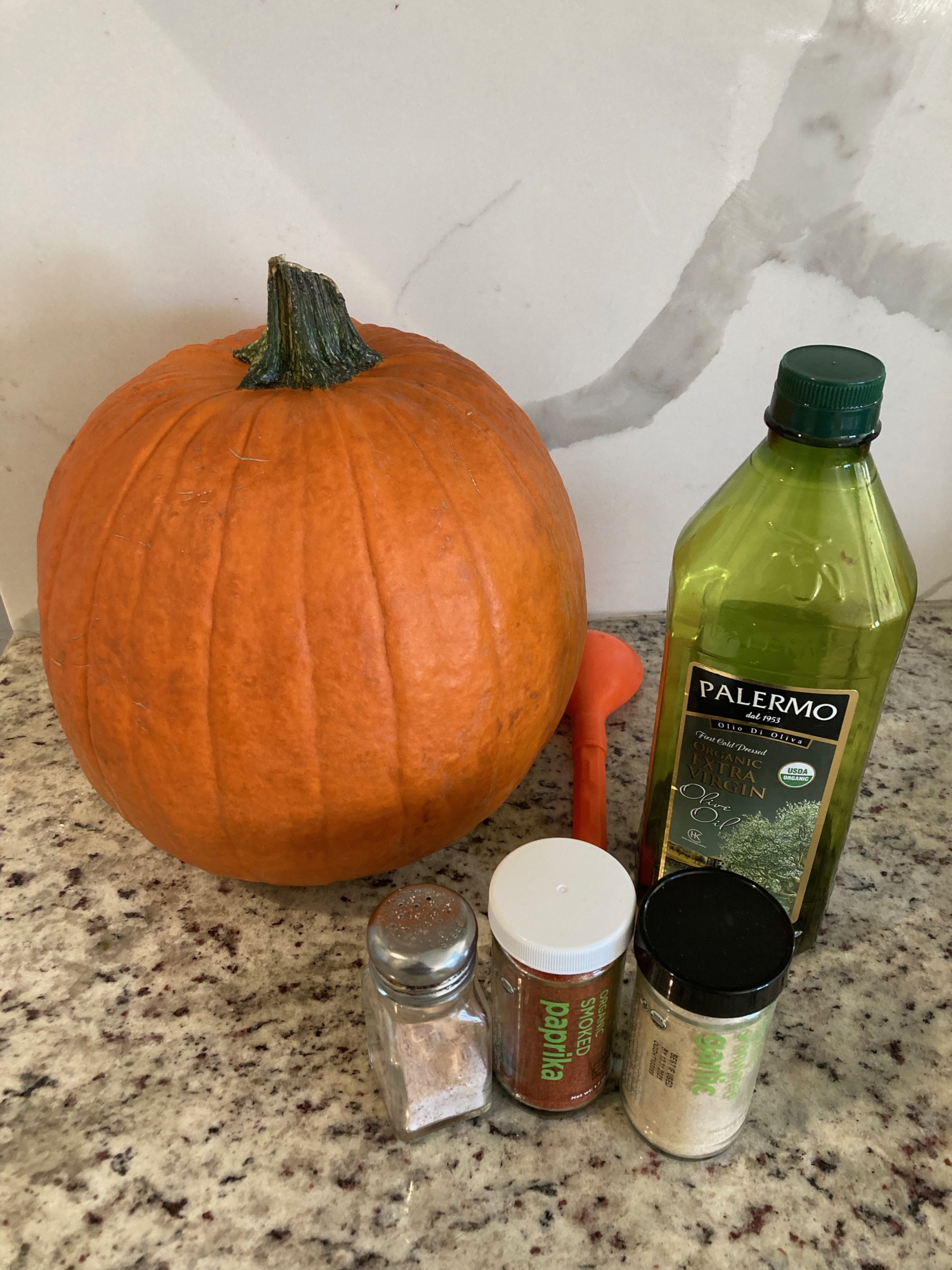
Step 1: Heat the oven to 350 F.
Step: 2 Scoop the seeds out of the pumpkin. Pick the seeds out of the pulp.
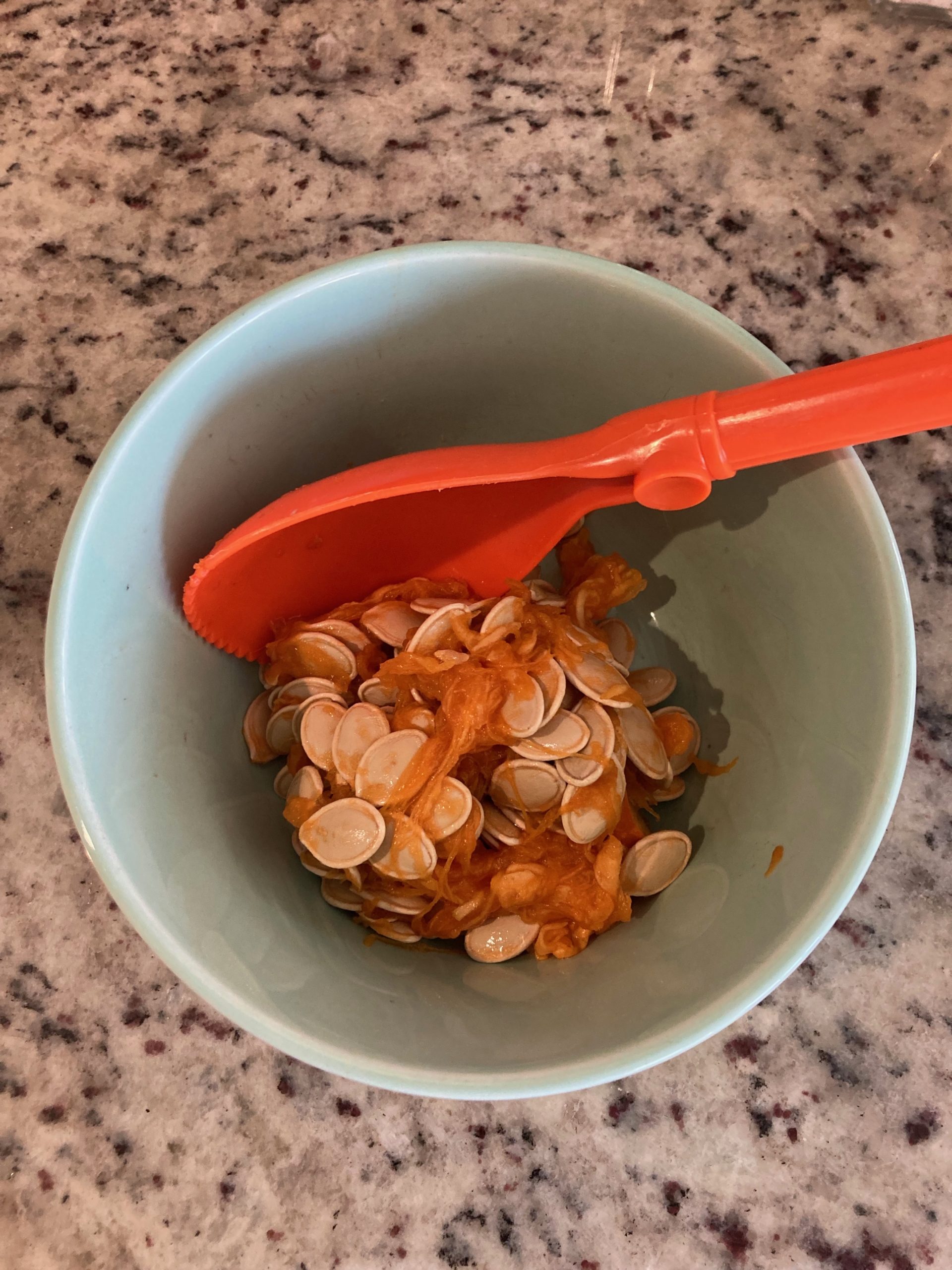
Step 3: Dry the seeds. Put them in a bowl.
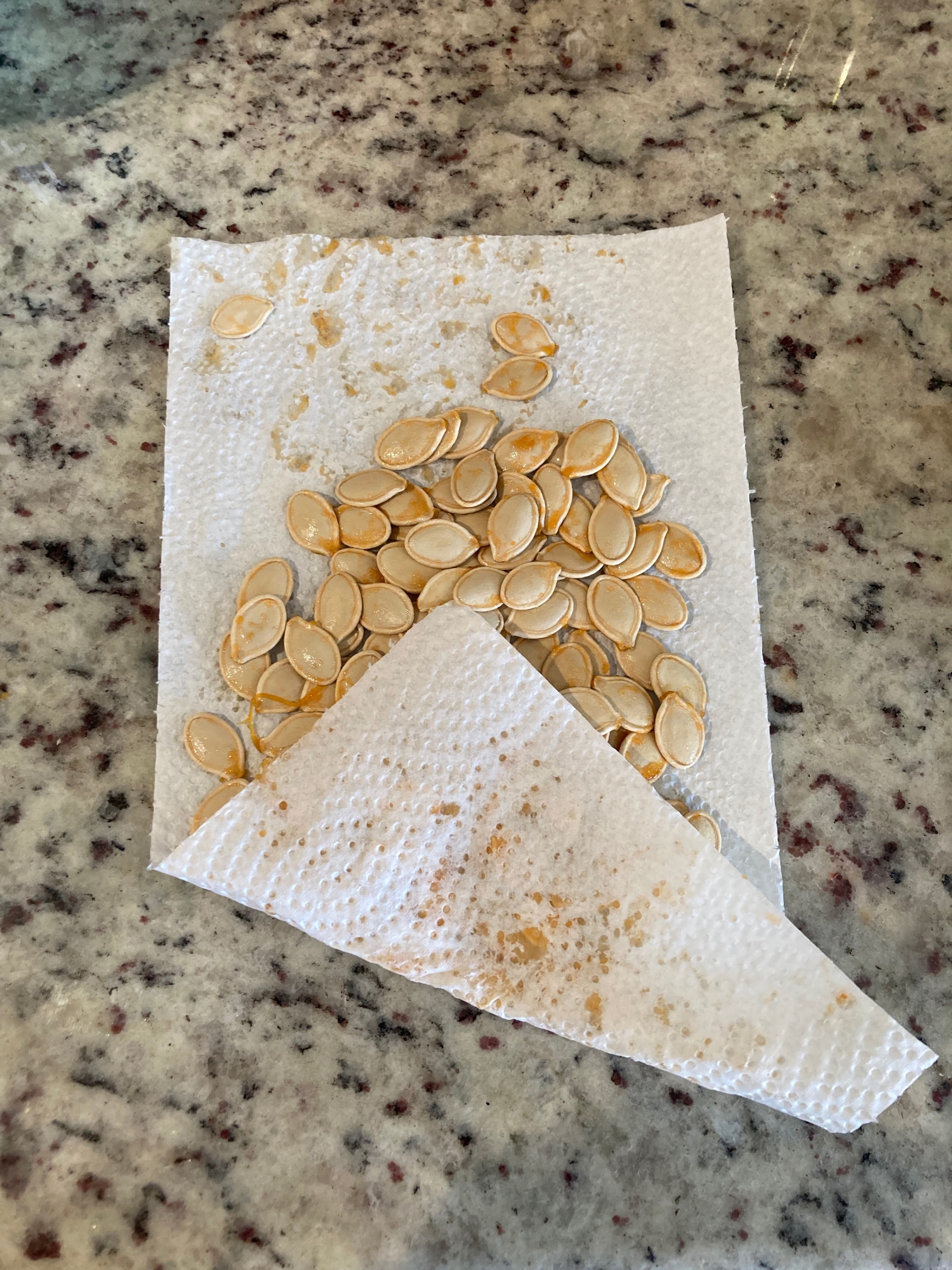
Step 4: Add a little oil and some salt, garlic, and paprika. Stir well with a spoon.
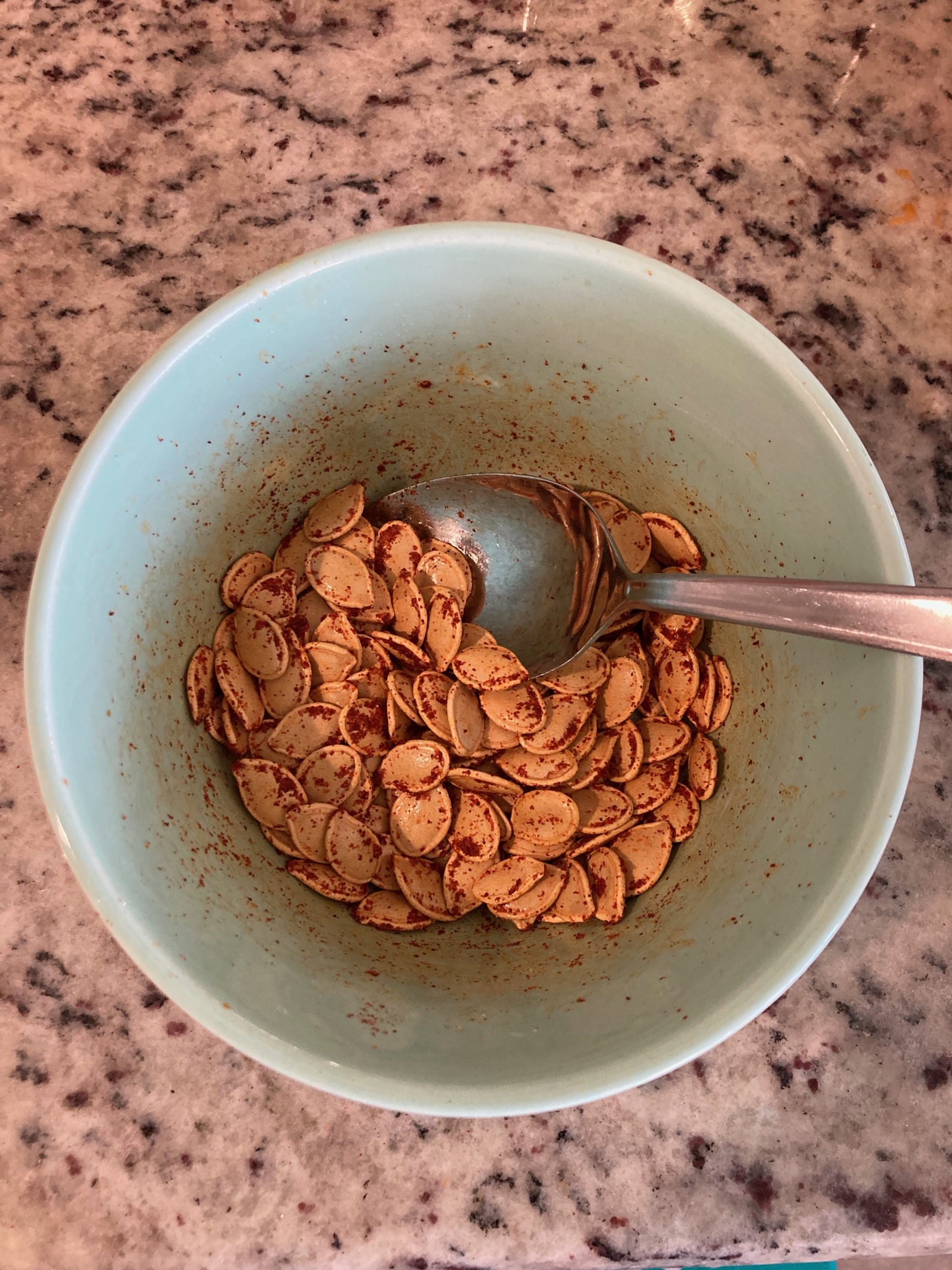
Step 5: Lay the seeds flat on a baking sheet. Put them in the oven.
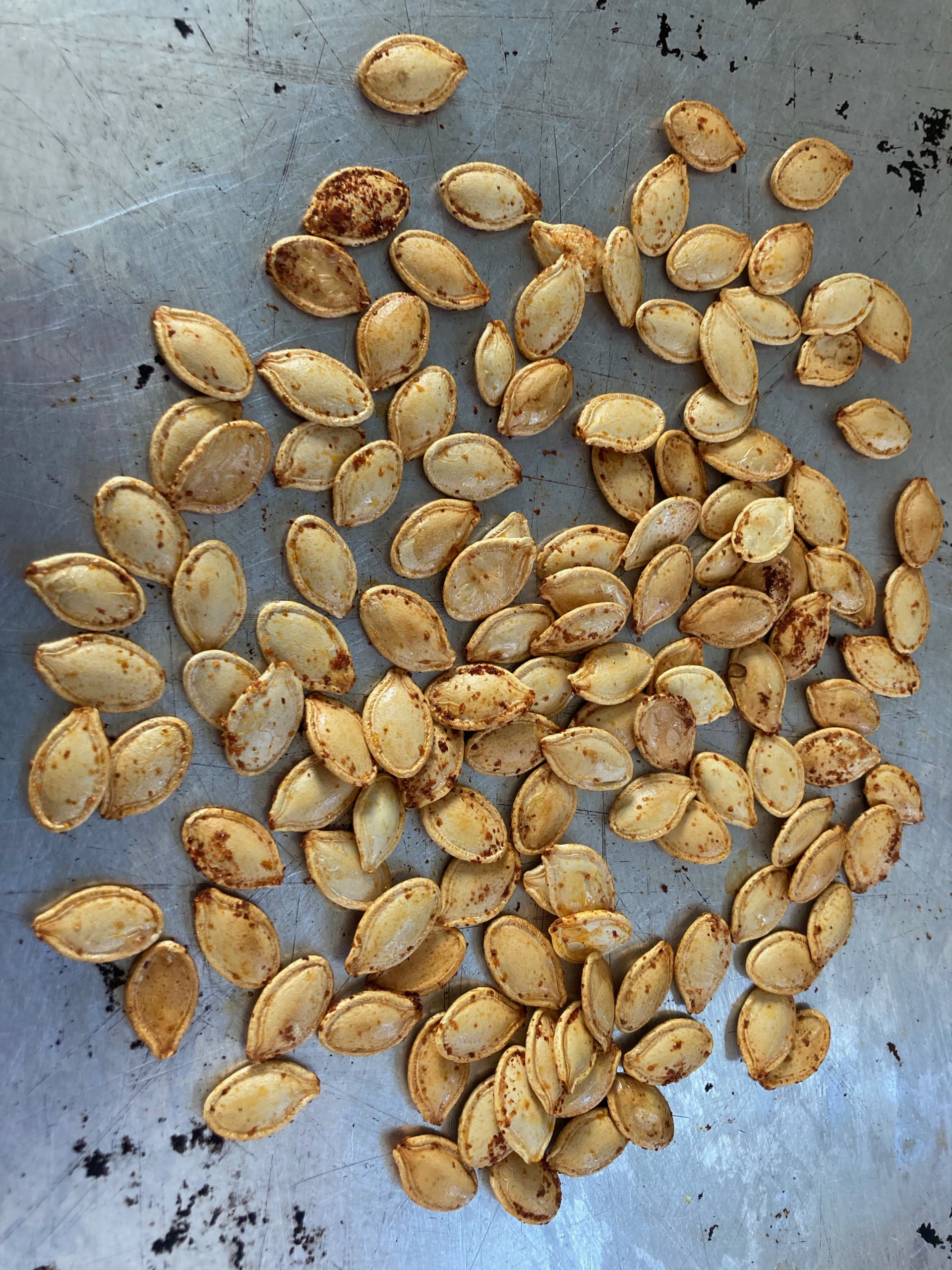
Step 6: Check them after 10 minutes. Seeds are done when they are crisp and brown.
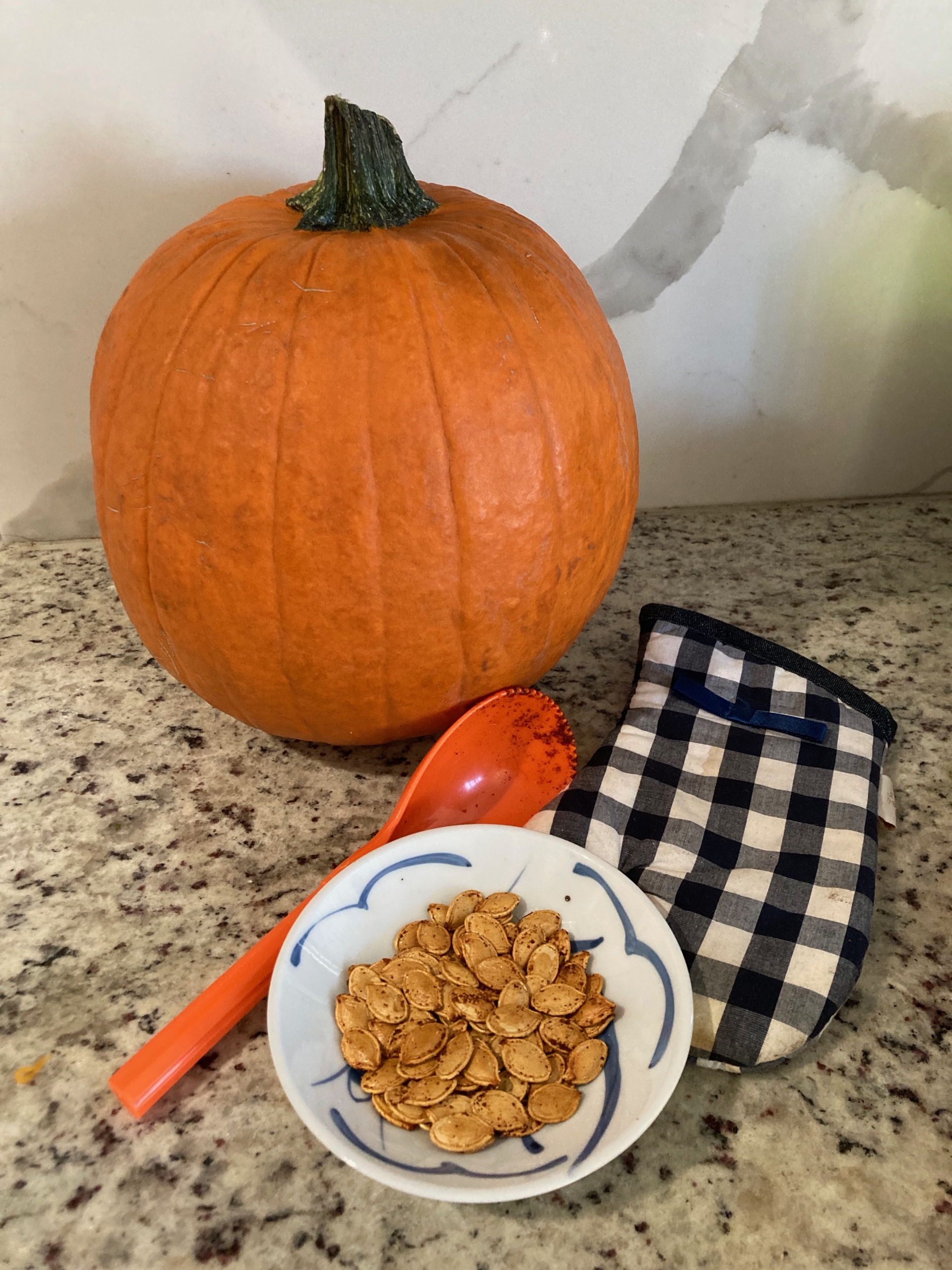
Enjoy!
One of the big stumbling blocks for kids learning to read is the multitude of spelling variations in the English language. Take the letter combinations IGH and IGHT. No child attempting to sound these out would guess that they indicate a long i sound (or, in combination with E or A, a long a sound), yet they do.
While thankfully these spelling patterns only feature in a relatively small selection of words, they’re found in some very common ones—and some very festive ones. This holiday lights craft and reading game takes advantage of seasonal words from light and bright to neigh and sleigh to highlight these unusual letter combinations.
Use this tutorial to craft a colorful, creative activity that offers a playful way to practice words spelled with IGH and IGHT. Because, from fishing for alphabet magnets to layering spelling s’mores, kids learn through playing.
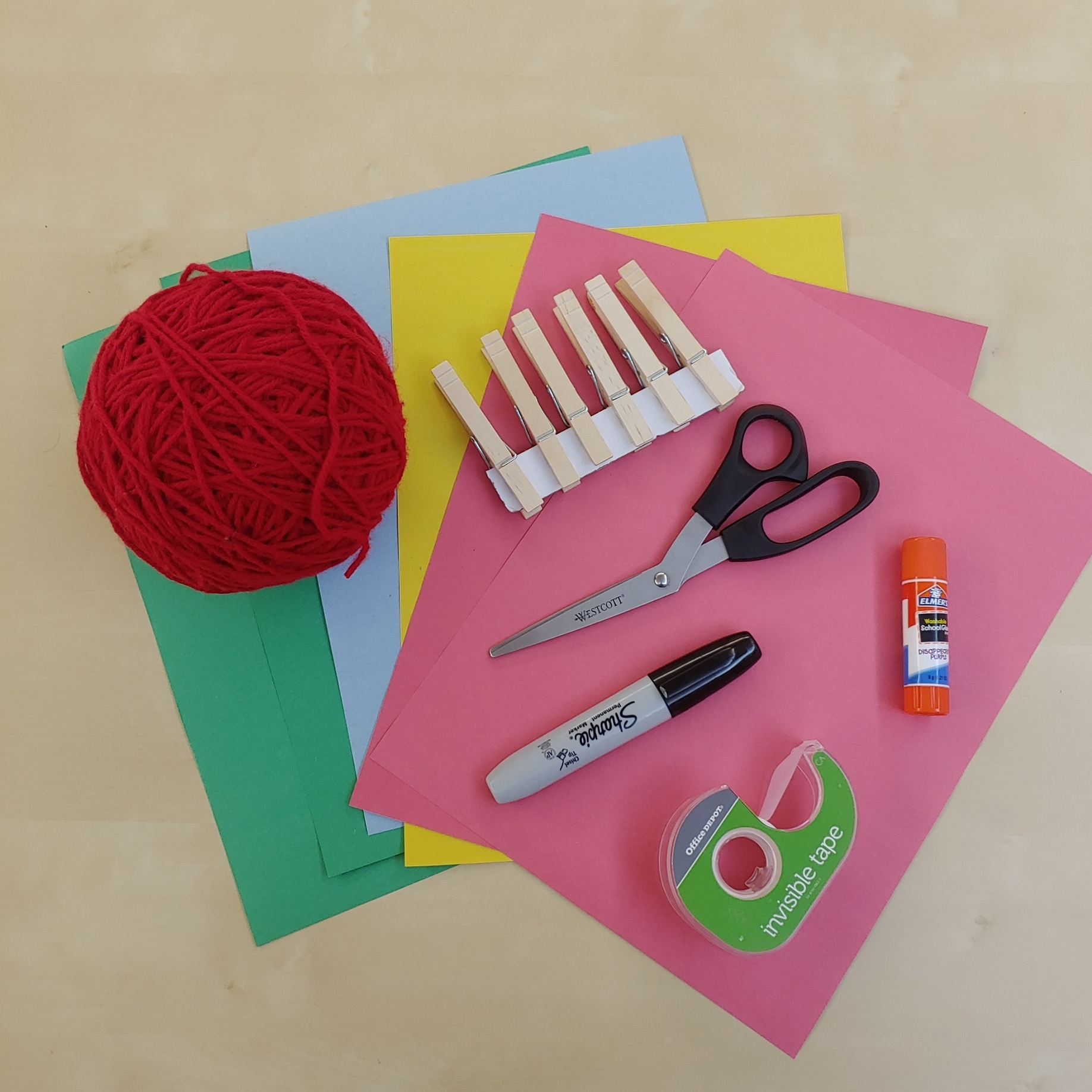
Materials:
- Wooden clothespins (6)
- Construction paper (multiple colors)
- Yarn
- Glue
- Tape
- Scissors
- Pen or marker
Cost: $5-10
Set the Scene (Optional)
Set the mood for your crafting session by settling in and reading a book about the holiday season. New approaches to classic Christmas tales, such as Silent Night by Lara Hawthorne, and ‘Twas the Night B’Fore Christmas: An African-American Version by Melodye Rosales, will delight your child and give them plenty of opportunities to see IGH and IGHT words in action.
While assembling the game pieces, you can further enhance your child’s mastery by referring to words that you read in the book. Discussing what the words mean, how they fit into the story, and how they relate to your child’s life can increase their vocabulary, as well as improving their reading skills.
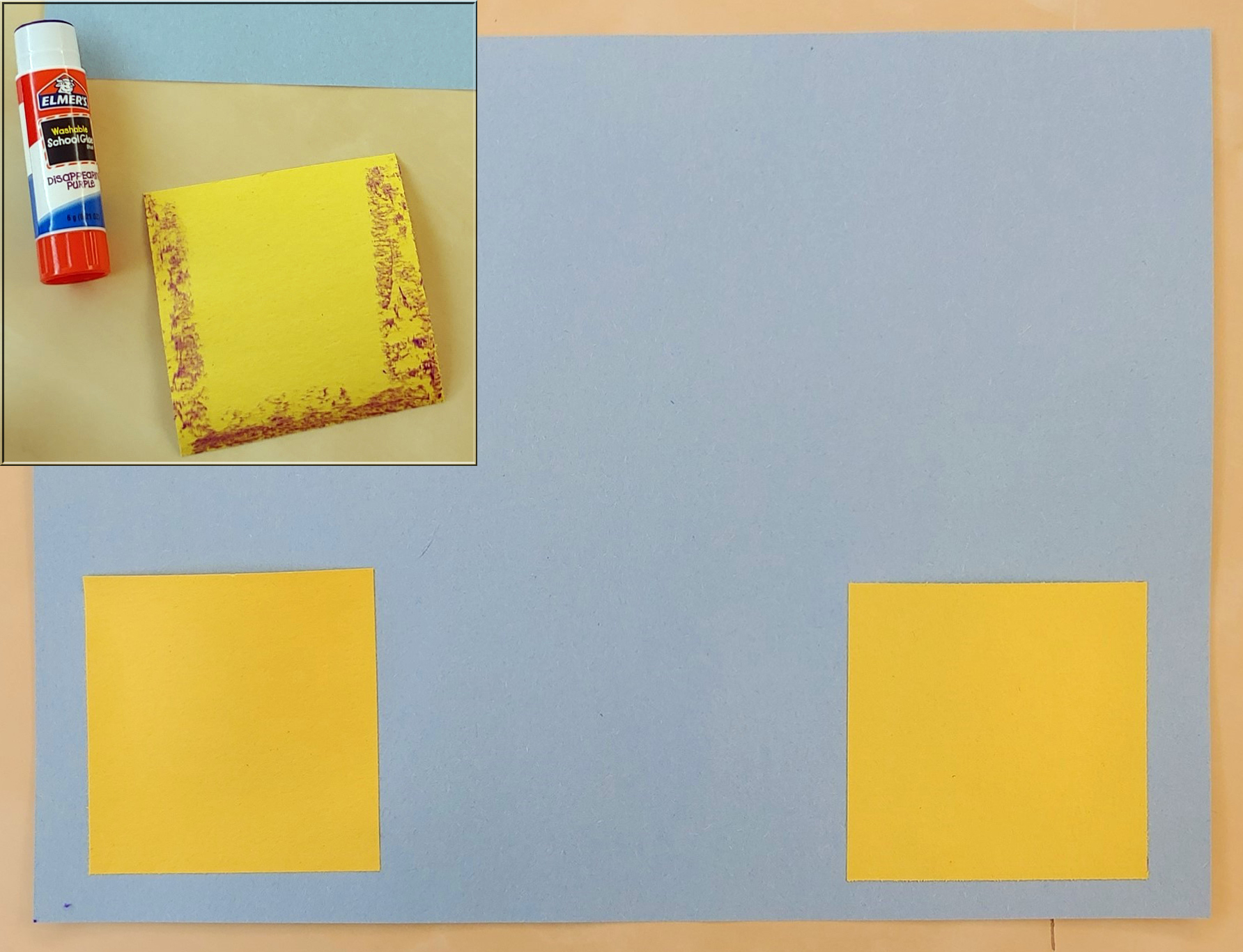
Step 1: Choose a piece of construction paper for your base. Then, using a different color than your base, cut out two three-inch by three-inch squares. Apply glue to the squares on three sides, then stick them to the lower corners of your base sheet of paper. Leave the top of the square open, creating two pockets.
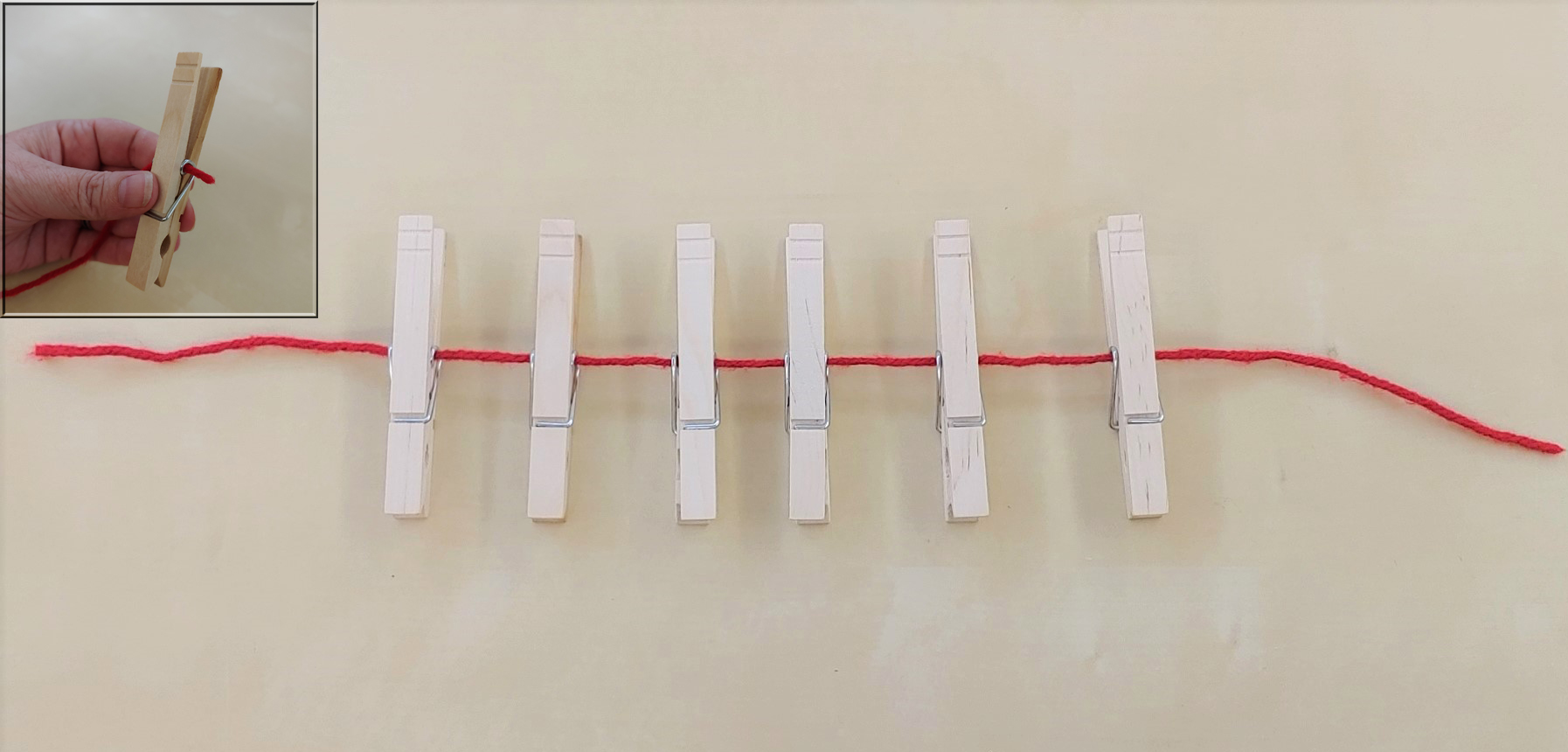
Step 2: Thread the yarn through the metal loop in the clothespin to create a stable line. Thread together a total of six clothespins.
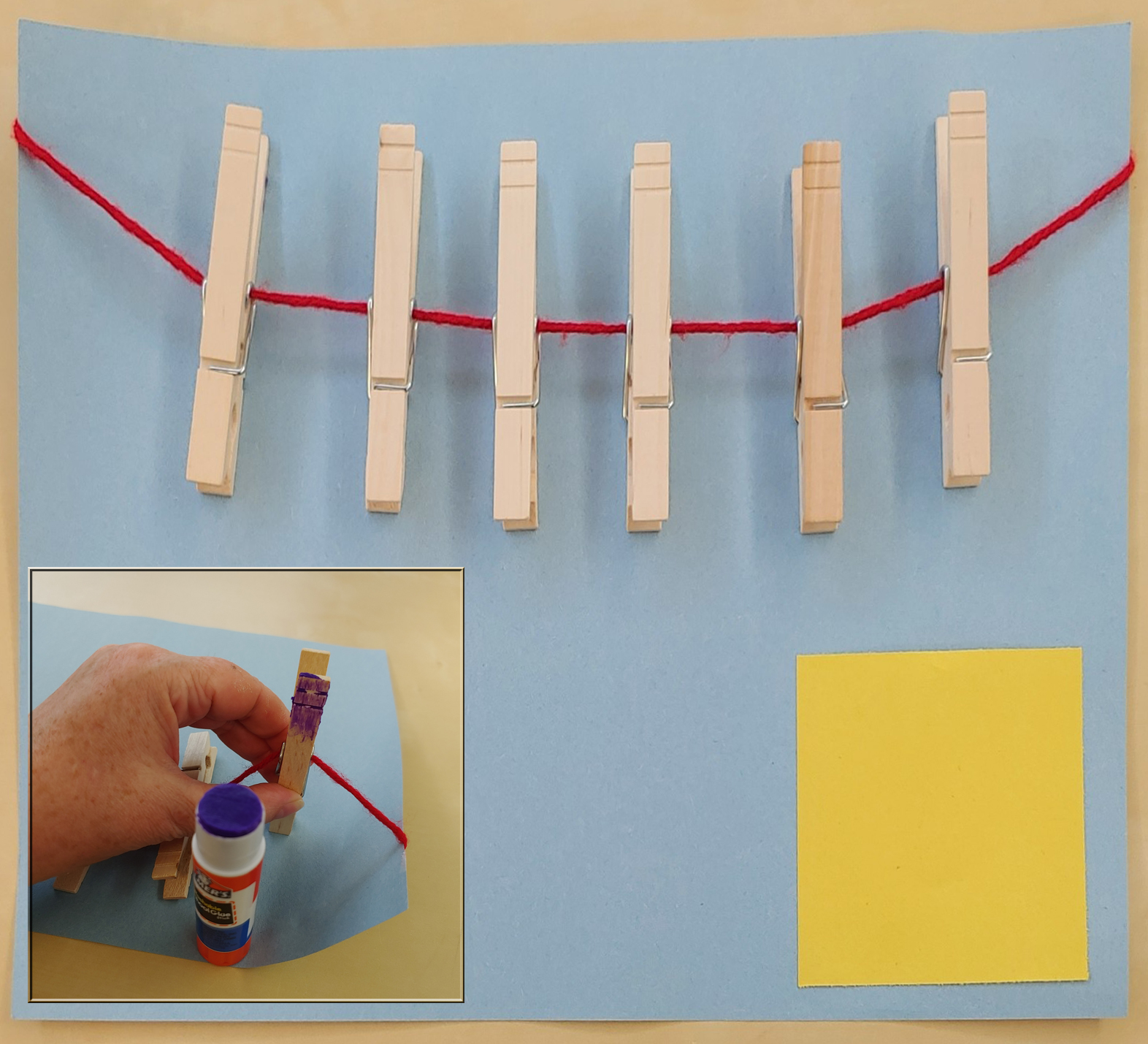
Step 3: Lay the threaded clothespins on the construction paper. Position them above the pockets, close to the top of the paper. Wrap the ends of the yarn around the edges of the paper and tape them to the back, about half an inch from the top.
Add a thin layer of glue to the back of each clothespin and press it into place. Keep the clothespins as evenly spaced as possible.
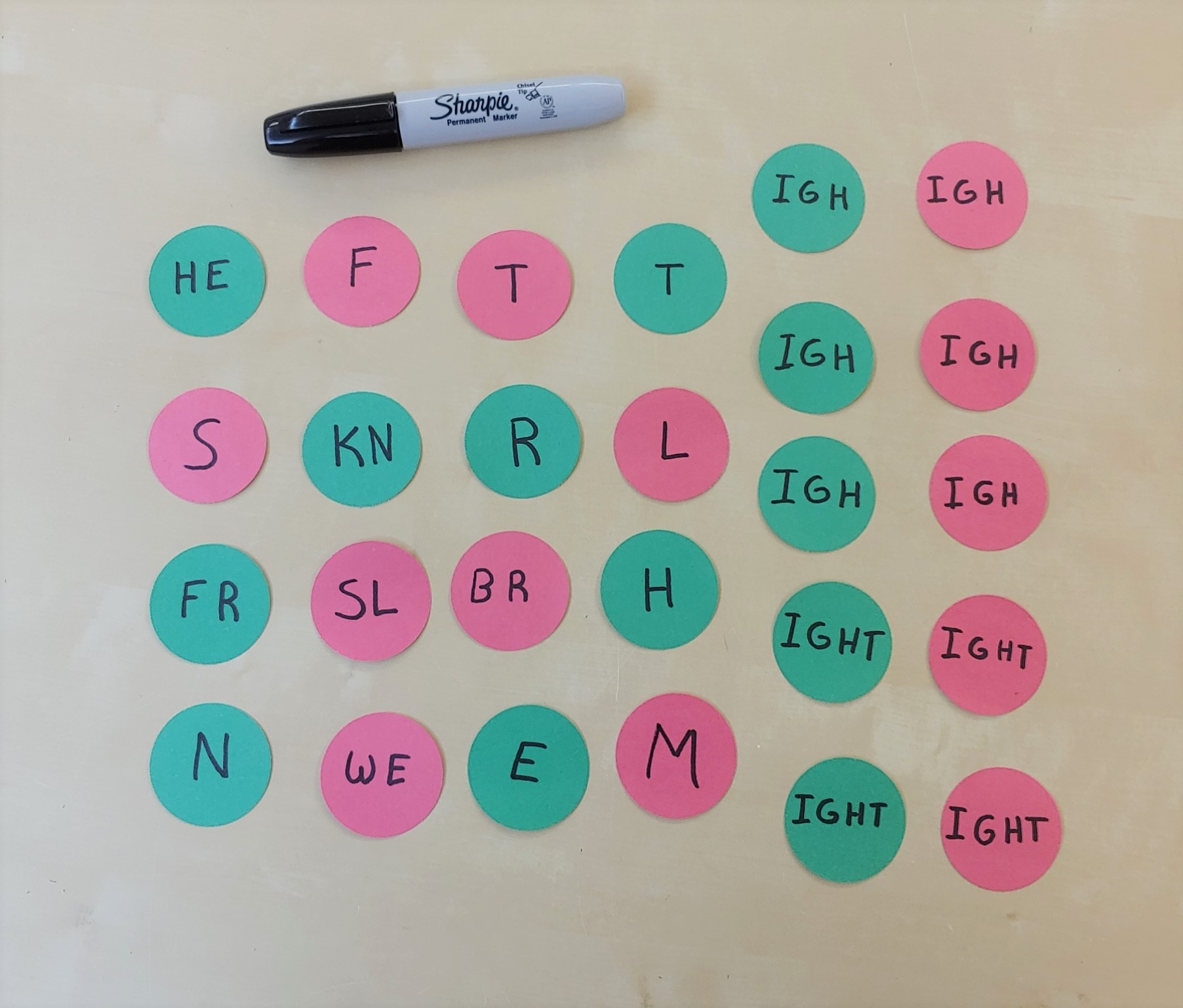
Step 4: Cut out around 25 to 35 one-inch circles in two or more holiday colors. Cut out an equal number of small rectangles, approximately half an inch long and a quarter-inch wide.
Write the letters IGH and IGHT on two or three circles of each color. Adorn each of the remaining circles with the other letters that make up IGH and IGHT words. Select words from the lists below, or use them all.
Tip: For beginners, start with the words that make a long i sound, then add in the long a sound words later for an extra challenge.
List of simple IGH and IGHT vocabulary words:
Words that make a long i sound: bright, fight, flight, fright, height, high, knight, light, might, night, right, sigh, sight, slight, tight
Words that make a long a sound: eight, neigh, sleigh, straight, weigh, weight
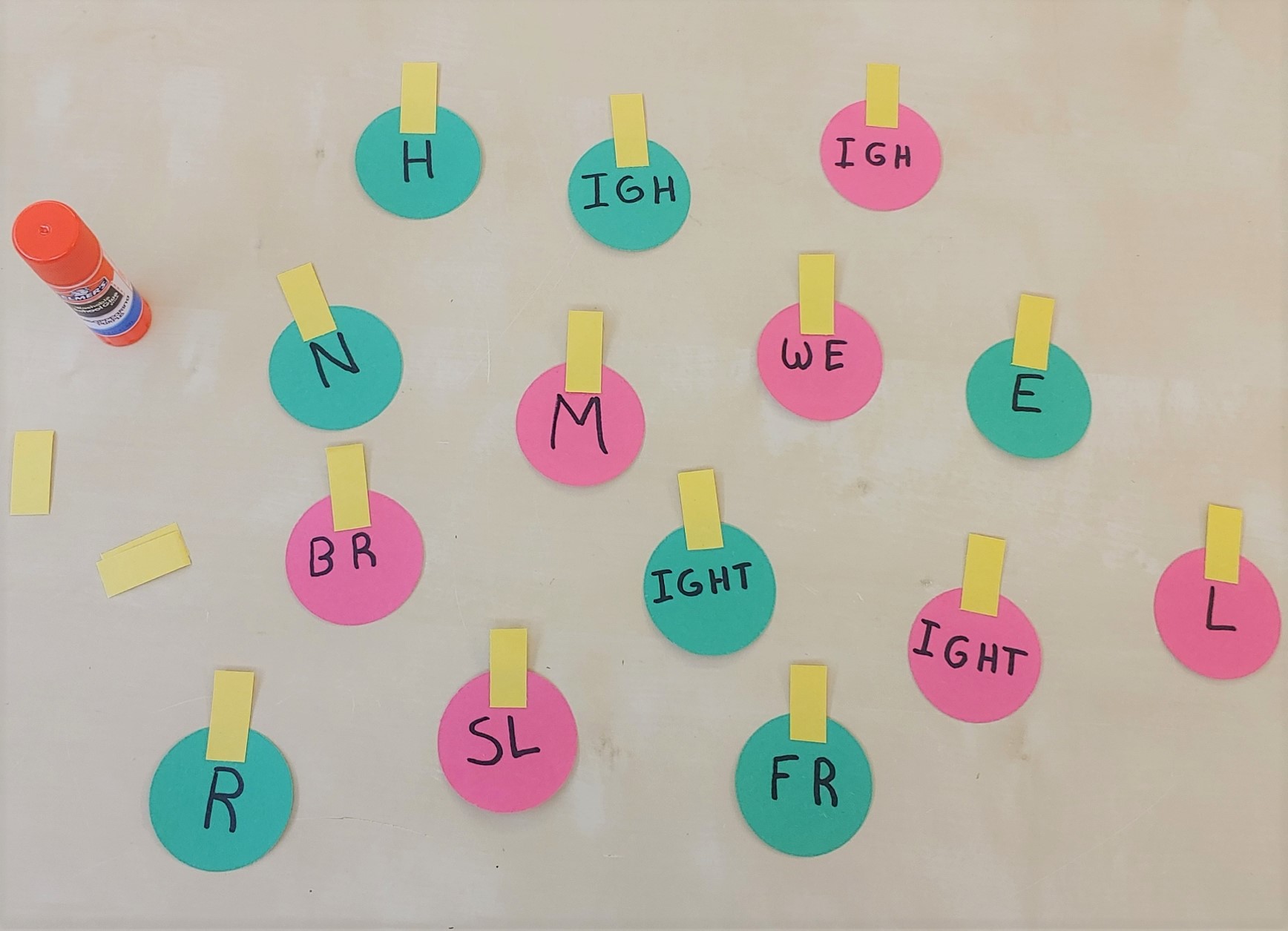
Step 5: Glue a yellow tab to each circle, transforming it into a Christmas light bulb, and allow to dry.
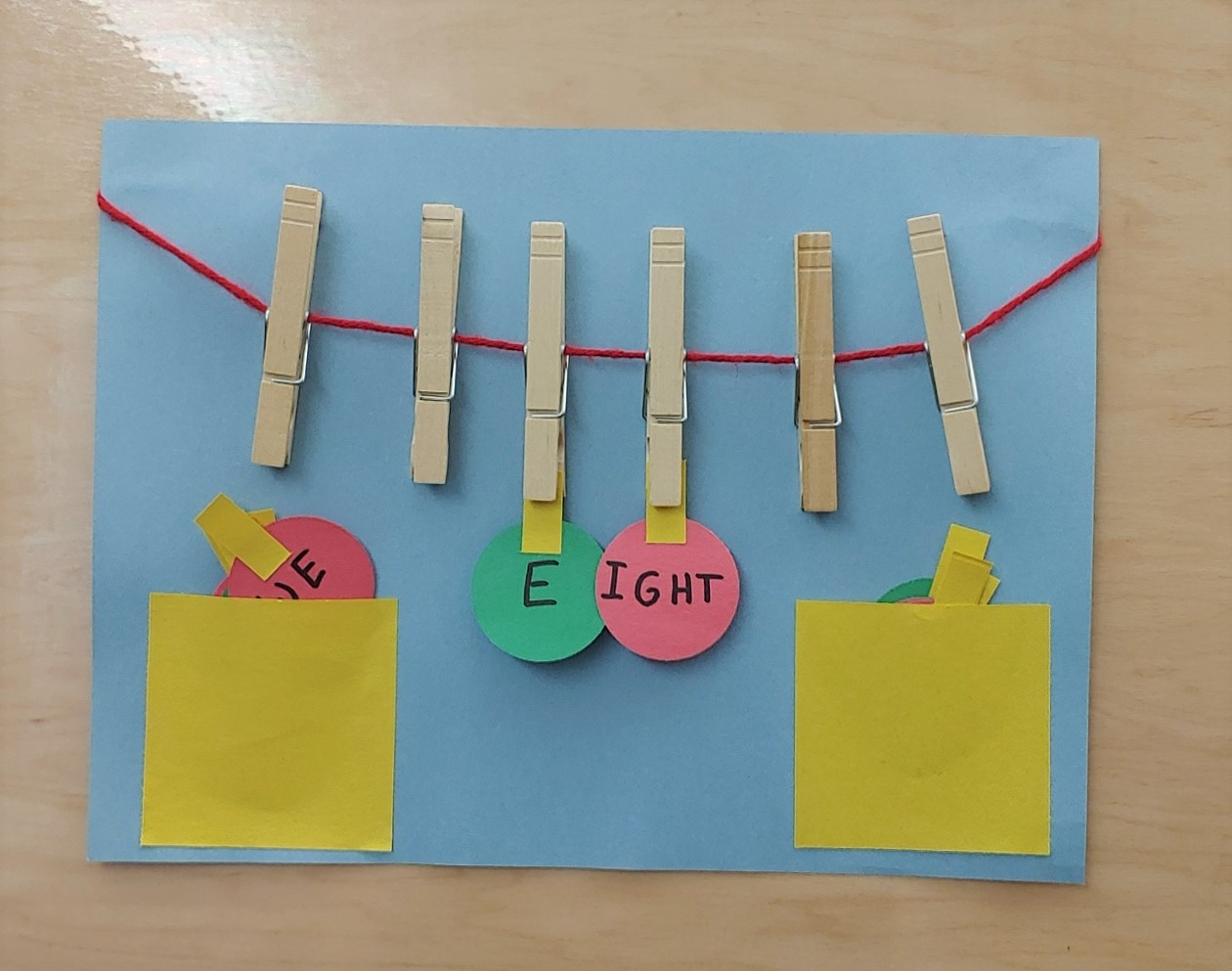
Step 6: Tuck the paper Christmas lights into the pockets.
How to Play: Introduce the IGH and IGHT letter combinations to your child, or review if they’re already familiar with them. Go over the concept that words with the long i sound can be spelled several ways. The letters and letter combinations I, Y, IE, IG, and IGH can all make a long i sound. Explain that words with the IGH letter combination are often followed with a T, creating words like sight and, of course, light.
Hang the game on the refrigerator with magnets, on a door with tape, or on a cork board with pins, and start playing! Show your little one how to hang their Christmas lights by clipping the yellow tabs into the clothespins. Explain that choosing different bulbs or switching up the order will result in new words, and then help them read the words that they create.
Extra challenge: For kids who are ready, explain that adding an E or A before these letter combinations can form a long a sound instead. Introducing words such as eight or straight will keep this game challenging for more advanced readers and spellers.
We hope this simple, DIY holiday lights craft and game will delight your child and make learning to read and spell these unusual words a lot more fun.


